|
Getting your Trinity Audio player ready...
|
This article will focus on the Brainard Recreation Area, a popular entry point to the Indian Peaks Wilderness. All three of its alpine basins, which offer plentiful skiing opportunities, will be examined from North to South: Blue Lakes Basin, Pawnee Basin and Isabelle Basin.
Overview
Tucked along the Continental Divide in northern Colorado is a wilderness that rivals the beauty of Rocky Mountain National Park at only a fraction of its size. The Indian Peaks Wilderness (or IPW) has long been a famous adventure destination for Front Range enthusiasts due to its prime location and stunning natural beauty. The wilderness is over 76,000 acres in size, straddling an uninterrupted section of the Continental Divide only an hour from the north Denver metro area. Peaks in the wilderness routinely pierce 13,000 feet, and the area is ripe with wildflowers and alpine lakes. During the winter months, the Indian Peaks host some of the most popular and epic backcountry runs in the northern half of the state. Like its national park neighbor to the north, the variety is astounding and the rewards plentiful.
This is the second of four articles attempting to detail the most popular backcountry lines in the IPW. This particular article will zero in on the Brainard Recreation Area, one of the most popular access areas to the IPW. Three exquisite alpine basins exist here, each ripe with ski potential. The article will cover all three basins from North to South.
Backcountry Skiing comes chock full of benefits and risks, almost in equal measure. It is a discipline that rewards methodical and purposeful learning with a deeper connection to nature. It can also be very dangerous for the uninitiated and seasoned veterans alike; avalanches don’t pick favorites. However, by arming yourself with the right gear and planning knowledge, backcountry skiing can satisfy the outdoor itch for multiple lifetimes.
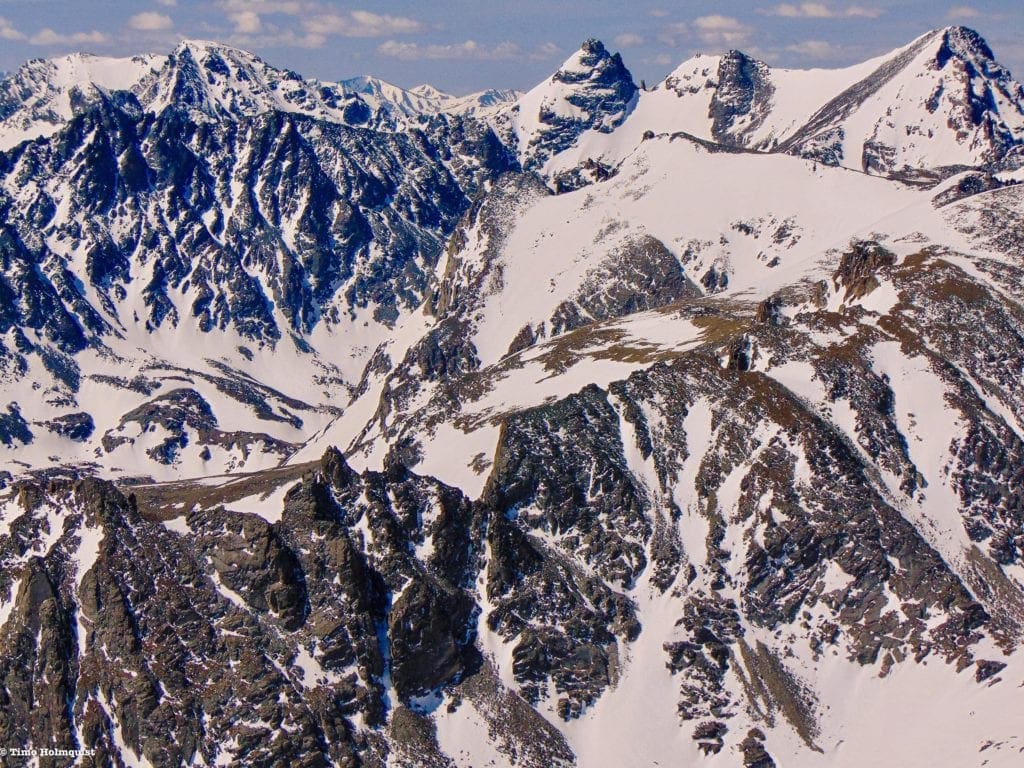
Photo of the The Indian Peaks. The tallest peak to the right is Apache, and the snowcone to the left is Navajo.
Quick Navigation
Article Navigation: Click on any of the listed items in the table of contents below to jump to that section of the article. Similarly, clicking on any large, white section header will jump you back to the Table of Contents.
- Backcountry Gear
- Backcountry Planning
- Indian Peaks Wilderness Overview
- Indian Peaks Weather
- Brainard Area Overview
- Blue Lakes Basin
- Pawnee Basin
- Isabelle Basin
- Quick Terminology Reference Guide
- Final Thoughts
- Additional Resources
Backcountry Gear
Before we begin, let’s lay out some quick backcountry gear knowledge (for a more comprehensive guide, check out our article, Backcountry Gear: Essentials for Human Powered Skiing). The list below is crucial, don’t skimp on gear when avalanches are in play.
- Skis/Helmet/Gloves/Goggles
- Winter Clothing: waterproof shells, thick ski socks, layers, puffy, beanie, hand warmers, etc.
- Skins
- AT Bindings (Frame or Tech)
- Avalanche Gear: Beacon, Shovel, Probe, and Radio
- Backcountry ski pack
- Food/Water/First-Aid Kit
- For multi-day adventures: 4-season tent, winter rated sleeping bag, avalanche airbag, orienteering equipment, batteries/rechargeable batteries
- Mountaineering Axe and Crampons. While there are hundreds of lines that do not require these tools, some of the most epic lines in the Indian Peaks Wilderness do. Research which crampons fit over your alpine or tech boots before buying! Generally speaking, you do not need an “Ice” axe unless you are climbing an ice wall; a mountaineering axe should work fine for most couloirs. However, some of the hardest ski mountaineering routes in the area demand more. Analyze your skill level and the route of choice BEFORE settling on gear options.
Remember, it isn’t enough to simply own gear; take the time to figure out how to use it before heading out. Speed is key, especially in a backcountry avalanche rescue. Visit Backcountry Gear: Essential for Human Powered Skiing to get comfortable with the necessary gear and how to use it.
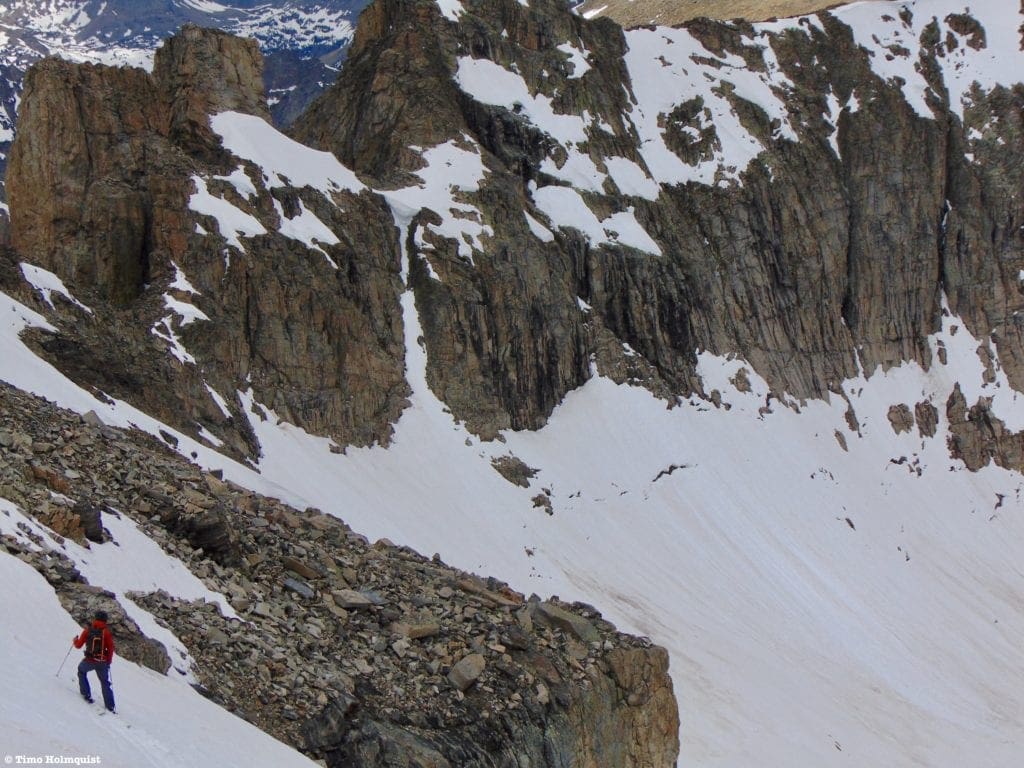
Backcountry skier scouting Queensway Couloir.
Backcountry Planning
Once you have the gear and know how to use it, it’s time to start planning. We’ll briefly break down the central components below, but check out our Guide to Planning a Backcountry Ski Adventure for an in-depth analysis of the planning process. A good plan can separate success from disaster. No outdoor activity is worth your life.
- 1) Pre-Planning
-
-
- Learn how to Ski at an EXPERT level before heading outside ski resort boundaries. Find a squad. Start backcountry gear research. Hone your craft. Get in shape.
-
- 2) Long-Term Planning
-
- Geographic reduction: where are you skiing? Start big, get small.
- Weather and snowpack research.
- Research ski lines using books, online resources, and forums. Key data:
- Total distance, total climb, total descent, slope angle
- Local Emergency contacts
- Unique factors: trees, cornices, couloirs, avalanche history
- Get into the maps and apps, know the area like the back of your hand.
- 3) Short-Term Planning
- Managing Expectations
- Constantly check weather updates until the morning you leave. Remember, snow reflects light, if it’s a sunny day, bring sunscreen!
- Popularity of your backcountry line.
- Tell people where you’re going and who to call if things go wrong.
- Have a back-up plan.
- Who’s got the medical training?
- Go over the plan in detail with your squad. CHECK FOR UNDERSTANDING.
- Packing
- Make sure everything fits, and you can access your avalanche gear quickly. Time is critical in a burial situation.
- Managing Expectations
- 4) On-site Planning
- What do you see when you get there?
- Watch out for tree-wells, wind-loaded slopes, cornices, bergschrunds, and other topographical considerations.
- Timing and snow surface i.e. environmental factors. Not all snow skis the same.
- What do you see when you get there?
- 5) Post-Planning
- Analyze
- What worked well? What didn’t?
- Ease into the harder stuff.
- Analyze
The steps listed above are only a skeleton outline; see our Guide to Planning a Backcountry Ski Adventure to iron out the critical details. Remember, you can always take an avalanche safety course through AIARE; it can absolutely save lives.
IPW Overview
The IPW is one of the most popular wilderness areas in Colorado, and for good reason. Parking lots at high elevation access points like Brainard Lake Recreation Area, 4th of July Trailhead, and Hessie Trailhead are routinely full by seven AM or earlier on summer weekends. While that can be discouraging from a logistical perspective, the vast majority of visitors don’t travel more than five miles from whichever respective trailhead they start from, and it’s really the deeper part of the wilderness that holds the magic. Determination, alpine starts, and distances traveled reward the intrepid adventurer with hundred-mile vistas, pristine alpine lakes, and nature aplenty. This is especially true for late winter and into early spring when some of the most popular access roads remain closed due to excessive snow pileup.
Between Berthoud Pass and Trail Ridge, there is a 75-mile uninterrupted stretch of the Continental Divide with the Indian Peaks sitting right in the middle of it. The linear aspect of the wilderness and the ranges in this part of the state provide fantastic perspectives east all the way down to the plains, some eight thousand feet lower than the highest peaks. Similarly, the expansive views westward provide unique perspectives of Lake Granby and Winter Park Ski Resort. To the north: Longs Peak is dominant, its blocky summit profile visible from nearly every major summit on the Divide. For such a compact wilderness, the Indian Peaks continuously impresses.
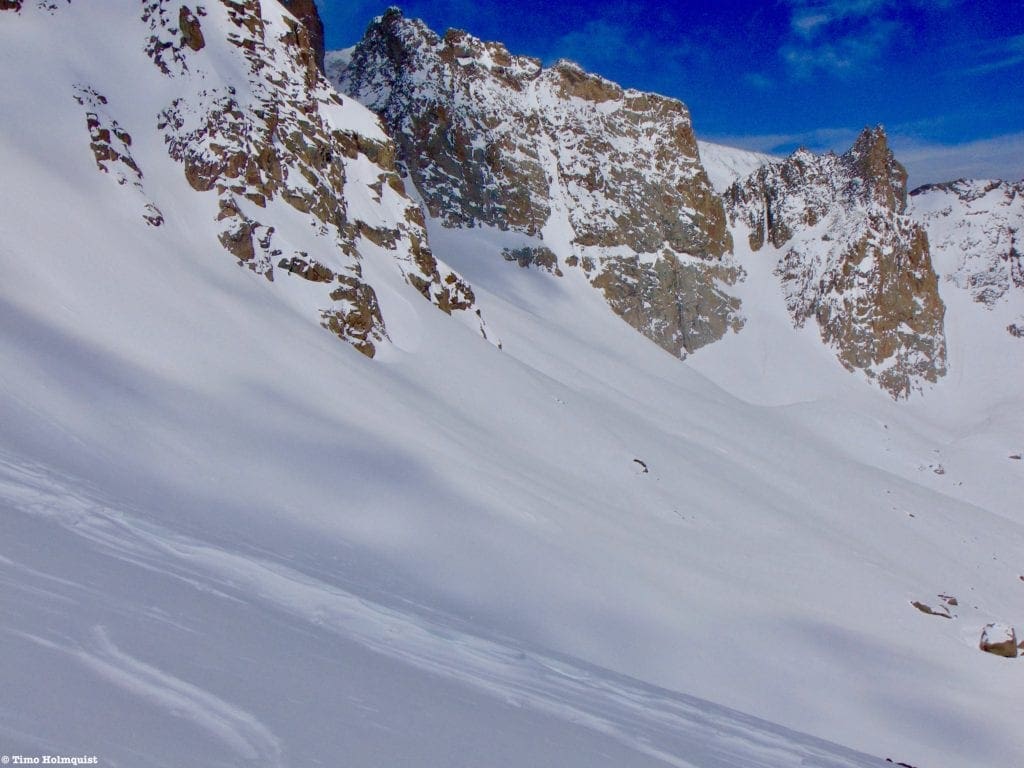
Typical IPW Alpine Terrain.
IPW Weather
Like Rocky Mountain National Park to the north, the Indian Peaks can be subject to high rates of snowfall, especially later in the winter into early spring. The weather tends to slam into the western part of the wilderness before lifting over the divide; however, upslope storms (east to west) are fairly common and can produce up to 60 inches in a 2-3 day stretch. Checking the forecasts for the wilderness area is as important as any of the backcountry planning steps listed above.
Focusing on the Brainard area of the wilderness, there are a few essential forecasts worth checking. First is the forecast for Brainard Lake, which sits just east of the wilderness boundary and has views of both the Isabelle and Blue Lake Basins. Secondly, the mountain forecast for Mt. Audubon is beneficial for the Blue Lake Basin, covering weather at three separate elevation gradients. Mt. Toll’s forecast is great for Blue Lakes Basin, Pawnee Basin, and Isabelle Basin. You can even use the forecast for Lone Eagle Peak to gauge conditions near Apache and Navajo Peaks. A little farther south, the mountain research branch of Colorado University has multiple weather stations atop Niwot Ridge, which help illustrate alpine conditions for the eastern portion of the wilderness.
Keep in mind there are multiple components to the weather; it’s not just about precipitation. The temperature will dictate what layers to bring, and local weather patterns will help you figure out what’s important. For example, in the IPW and the larger Front Range in general, make sure to check the wind forecast. The Front Range is notorious for strong, blustery winds, and fighting your way up to a ski line in 50mph gusts is not fun.
There are also Snotel weather station sites scattered throughout the backcountry offering snowpack data. It can be a bit confusing to sort through the site, but here is the interactive map option. Use the menu on the right-hand side to create specific condition queries. The linked map will open with a window to the station at Niwot Ridge. Snowpack data is really important for backcountry skiing; not only will it tell you if there is even enough snow to ski on, but it will also show you whether or not the area is experiencing an average winter. Any significant deviation away from average is noteworthy. Deep winters create more pronounced avalanche conditions, but wimpy winters can as well, especially if a storm overloads weak and unstable snow. Snowpack science should be a critical component of planning.
As crucial as snowpack data is, the numbers would be incomplete without an avalanche forecast. This forecast is MANDATORY before heading out. In Colorado, we are lucky to have the CAIC (Colorado Avalanche Information Center). The information is easy to read, the maps are color-coded, and a flurry of explanations gives depth to the forecast. More specifically, Rocky Mountain is in the Front Range Zone; make sure you are checking the right area for the most accurate information. Do not go into the Colorado backcountry without checking CAIC.
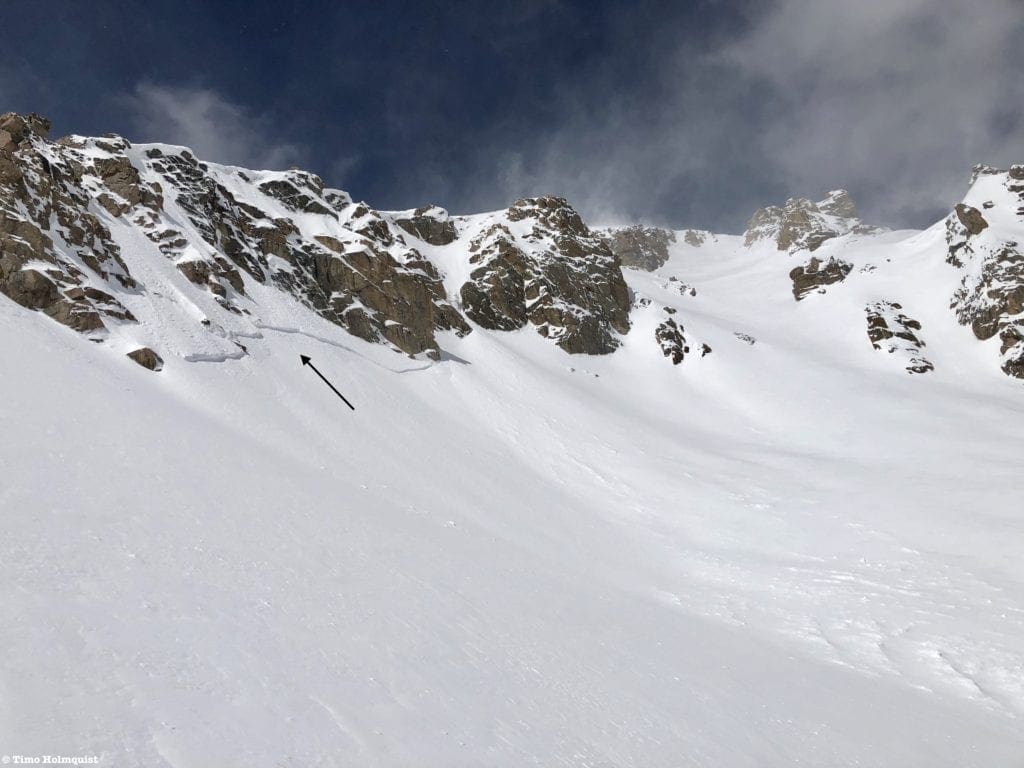
An example of Crowning, the top fracture surface of a recent avalanche.
Brainard Lake Recreation Area Overview
Brainard Lake Recreation Area is an immensely popular access point for the three basins described in this article. It is adjacent to the Indian Peaks Wilderness area and shares a lot of the same qualities, with the added benefits of paved road access, established campgrounds, and facilities. It is far and away the best way to get into the ski lines of the region.
The access road is gated at the Brainard Gateway Trailhead during the winter and spring, although the summer road continues another 3 miles to Brainard Lake and the Mitchell Lake and Long Lake Trailheads. Negotiating the extra 3 miles of road past the gate is your first challenge when pursuing winter recreation in this area. Through early April and especially after large storms, the road is covered and makes for a lovely cross-country ski adventure; in fact, many trails in the recreation area can be used for cross-country skiing.
This is arguably the most popular portion of the Indian Peaks because the views from Brainard Lake are majestic and easy to attain. There are no less than six mountains that (depending on conditions) provide summit direct ski descents of 2000+ feet. Isabelle Glacier also lives here and makes a fantastic destination in any season. Between glacial remnants, couloirs, alpine vistas and a plethora of beautiful summits, the Brainard area has the best ski variety on the eastern side of the wilderness.
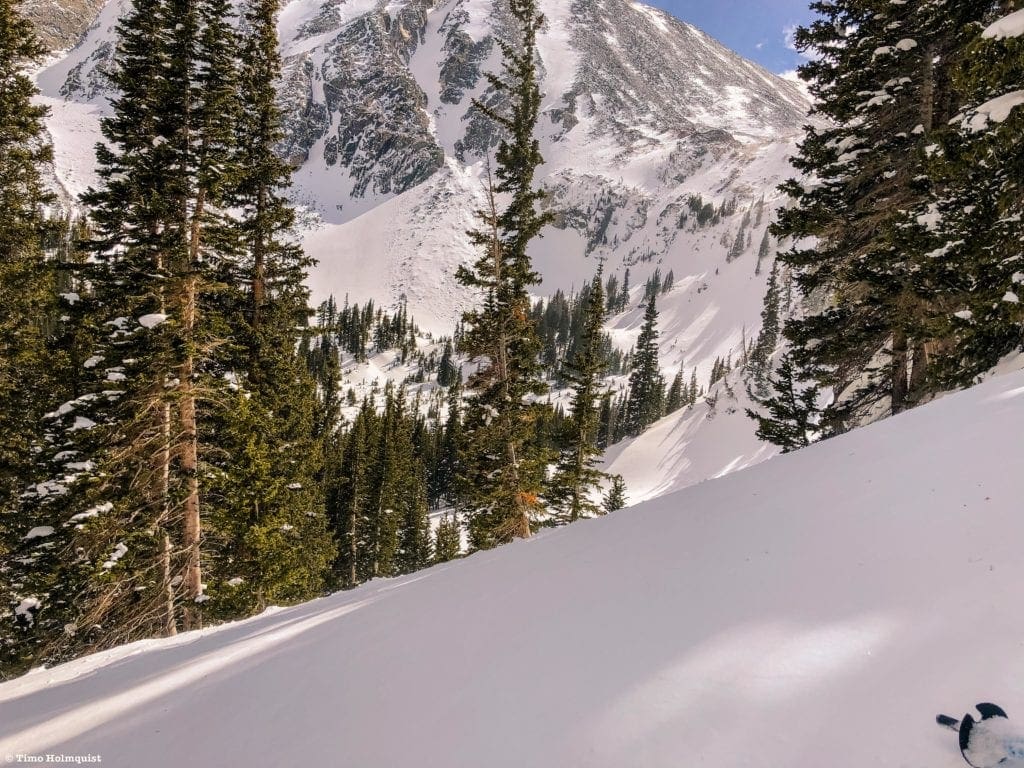
Near Lake Isabelle, Indian Peaks Wilderness, Colorado.
Access
Brainard Recreation Area is very simple to access from the East. Find your way to the CO-72 (part of the peak to peak scenic highway) and make your way north of Ned or south of Estes Park. Look for the well-signed Brainard Recreation Area and turn up the road (left if coming from Ned, right if coming from Estes) until reaching the Gateway Trailhead at the winter gate. If approaching from Boulder or Longmont, your GPS may want you to drive up Lefthand Canyon and through the town of Ward. This is a great approach as well. Ward is a small, tight community in a little holler below the Peak-to-Peak highway, SLOW DOWN, and drive through the town. Above it, connect with CO-72 (Peak to Peak), take a quick right, and then an almost immediate left onto the well-signed Brainard Recreation access road.
The winter gate closure is usually in place until June. From roughly March-April, depending on storm patterns, there may be enough snow to skin from the gate all the way back to your desired approach. After that, the road behind the gate may melt out. It is ~3 miles from the winter gate to the main trailheads. A great alternative from May until the gate opens is to pack a bike, load up, ride the road portion behind the winter gate until at least Brainard Lake, stash the bike and continue on skins. Either way, you’re looking at a long, demanding day in the wilderness: prepare accordingly.
Once the gate opens, access is easier but pricier, it’s $12 (vs. free at the gateway trailhead), and tickets are common. Additionally, waiting for the gate to open reduces your chances of a nice uninterrupted skin to your desired line, i.e. you’ll probably be carrying your skis. Condition wise, the ideal time to ski from the Brainard Gateway is late-March through late May.
Places to Stay
If you are staying in the Front Range, the Brainard area is an easy day excursion. Any place in Boulder is an hour or less from your main access point. If you’re visiting Rocky Mountain National Park, staying in Estes Park is a nice option. Please visit the town’s tourism site here to find appropriate lodging options. The town of Nederland is the closest to Brainard with multiple lodging options. Other places in the vicinity include the Allenspark Lodge B&B, and Sunshine Mountain Lodge and Cabins. Airbnb also has a few prime mountain cabins located in the hills around the area.
Our Ratings
Below you’ll find route descriptions, maps, and ratings as they pertain to the lines we cover. These articles cover the most reported and referenced lines, not all possible lines you could ski. We utilize a four-tier rating system illustrated as follows:
- Beginner (Green)
- Intermediate (Blue)
- Difficult (Maroon)
- Very Difficult (Black)
Some areas covered only exhibit a few tiers; others exhibit all of them. Regardless, it is important to understand that each rating does not ONLY correspond to the steepest slope angle skied. Some lower-angle Difficult terrain is simply difficult to access and requires an immense amount of effort to attain, hence the harder rating. Take the ratings seriously as the separation between Difficult and Very Difficult often involves many of the hallmarks of true ski mountaineering, ropes, legitimate ice axes, mountaineering crampons, etc. It is incumbent upon each reader to understand their limits. Always start small.
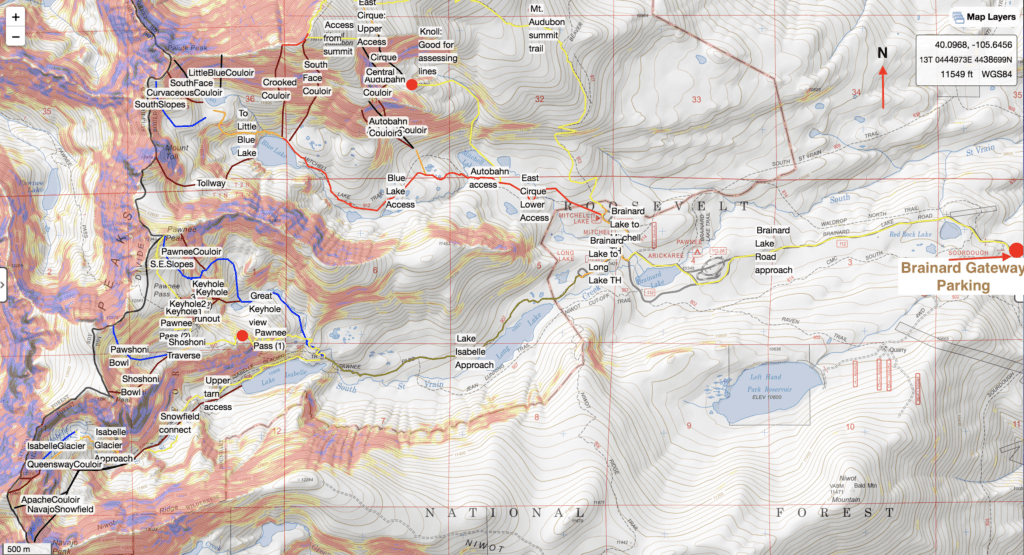
Overview Map: Basin Labels, maybe not line specific.
Blue Lakes Basin
Blue Lakes Basin is a beautiful, steep basin carved between five mountains, Mt. Audubon, Paiute Peak, Mt. Toll, Pawnee Peak, and Little Pawnee Peak. The best and most satisfying lines exist off of Audubon, Paiute, and Toll. Blue Lakes Basin is highly visible from Brainard Lake, making it a perfect first location to scout potential ski lines. The most popular ski line is on Mt. Toll, although Paiute and Audubon both sport amazing couloirs. Weeks’ worth of excellent ski exploration can be had in the Blue Lakes area.
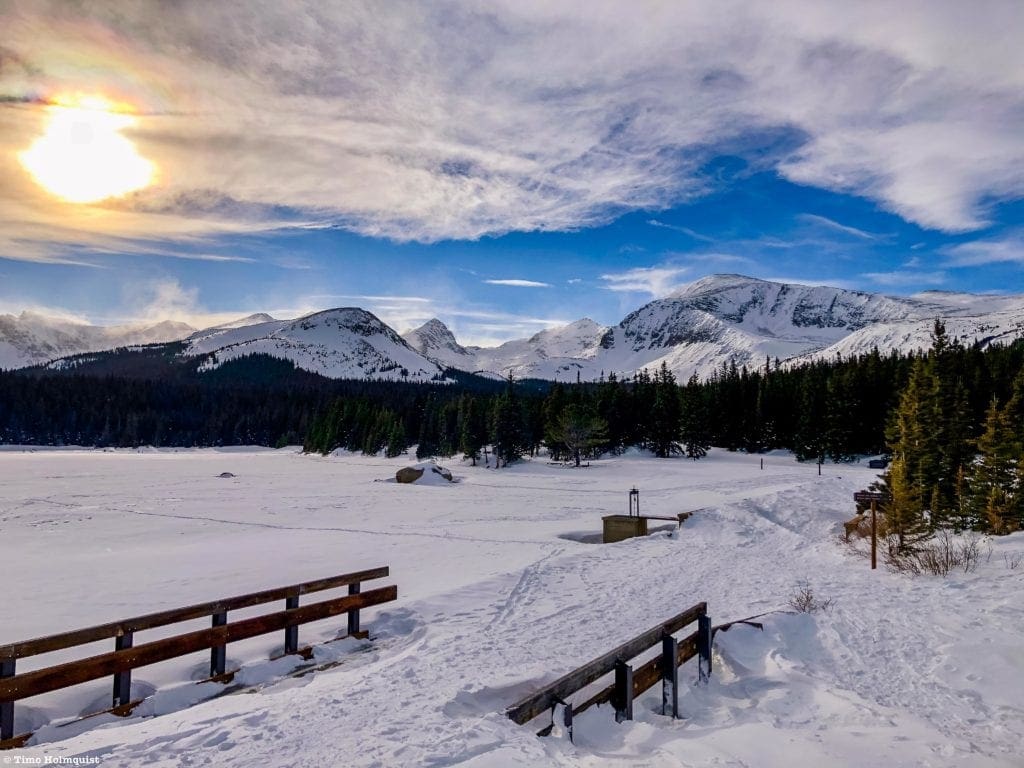
Blue Lake Basin from Brainard Lake.
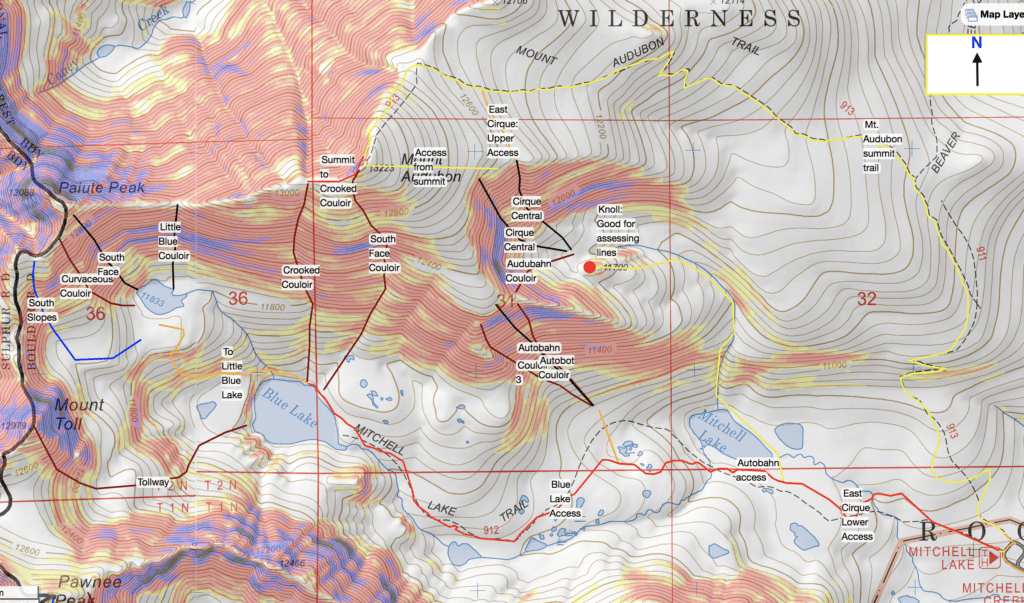
Blue Lakes Basin map.
Mt. Audubon: This large, complex mountain is the northeast anchor of Blue Lake Basin and has many interesting routes on it. The approach from Brainard Gateway Trailhead follows the road to Brainard Lake. At Brainard Lake, the main road circumvents the lake on its left (southern side), you want to veer right (north) and cross a bridge at the lake’s outflow. This area is open, and navigation is easy. Cross the bridge and continue on a wide service road until intersecting with the main snow-covered road after a gate. Take a right and follow the signs to the Mitchell Lake Trailhead. It will take 3.2 miles to get to Mitchell Lake Trailhead from Brainard Gateway.
Please Note: For each section of Audubon, I’ll provide statistics to either an upper or lower access (sometimes both), depending on what is most feasible for the desired ski line. Please keep in mind, lower access means statistics to the bottom of the line; you still have to climb to the top to ski it down.
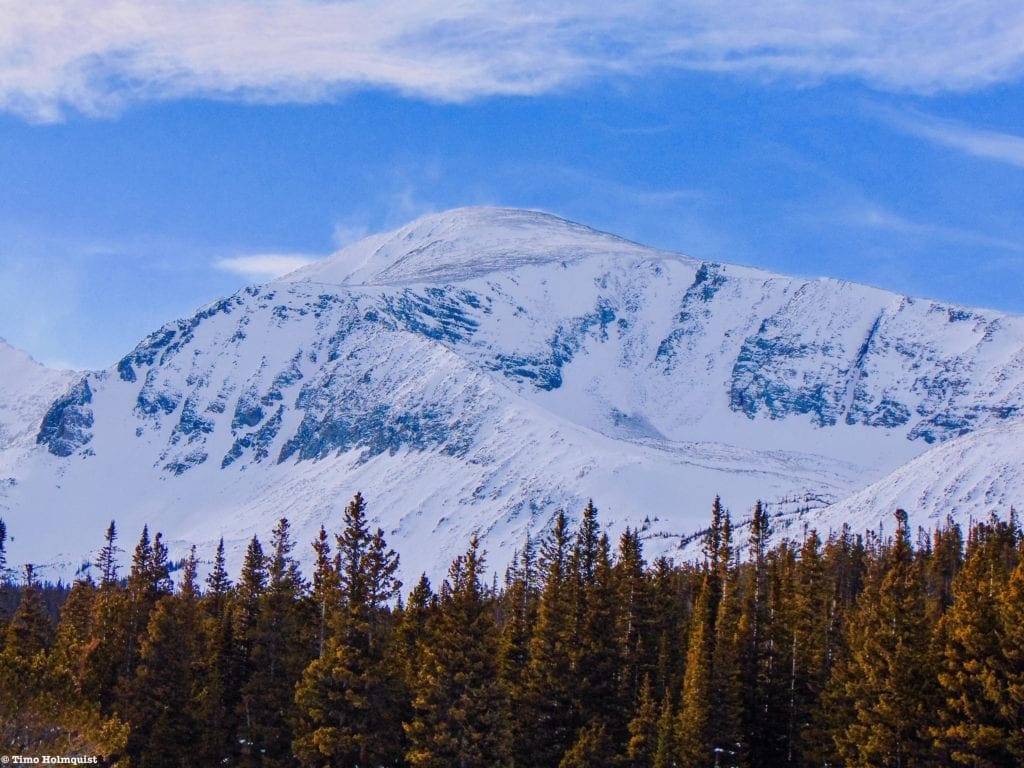
Profile view of Mt. Audubon.
Mt. Audubon: The East Cirque. The lines on Audubon can be divided into three areas. The first area is the East Cirque, which is quite visible on the approach route, although one line (Audubon) is not visible until you enter the Cirque. There are two ways to reach the East Cirque, by climbing up into it from Mitchell Lake (due north), or by taking the summit trail and dropping in from above. Approach stats from Brainard Gateway Trailhead are given for both options.
- Approach Stats to Lower Access: ~5.02 miles, ~1816 ft. of elevation gain.
- Approach Stats to Upper Access: ~6.41 miles, ~2594 ft. of elevation gain.
- Subtract 3 miles and ~600 feet when the winter gate opens. Keep in mind, conditions after the gate opens are variable, expect to carry your skis over certain areas. Don’t forget the $12 summer rec parking fee.
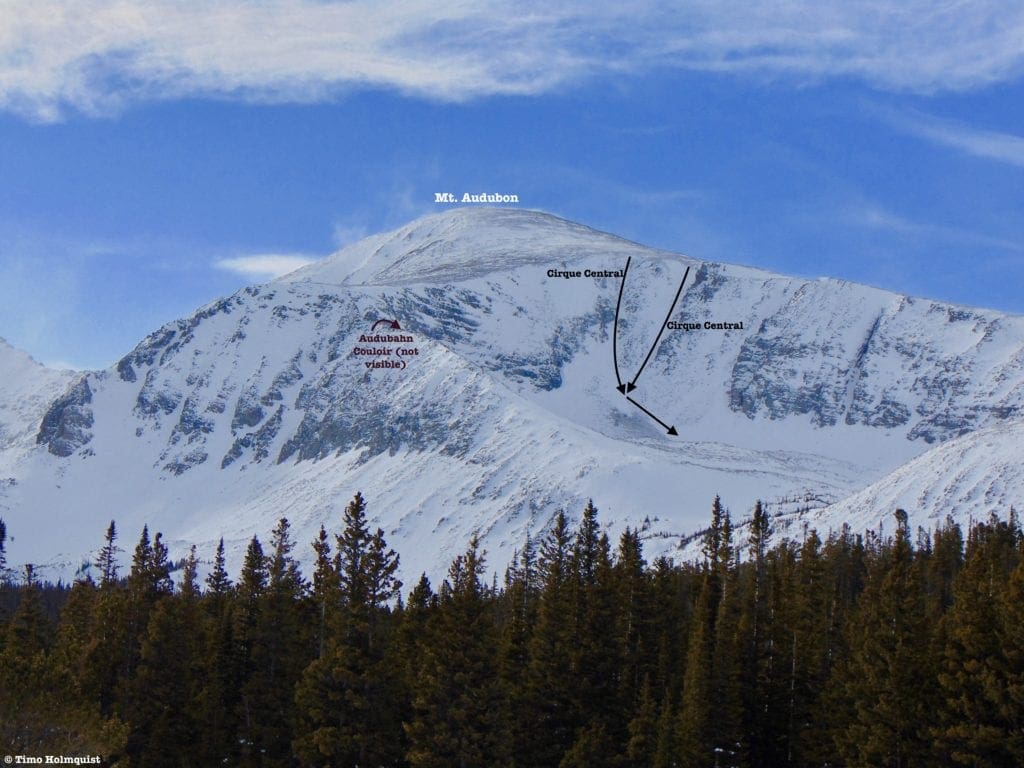
Mt. Audubon’s East Cirque.
Mt Audubon: East Cirque/Audubahn
- Essentials: 0.2 miles, 490 foot vertical
- Status: Difficult to Very Difficult
- Steepest slope angle: 45 degrees
- Good for: A quick challenge, or the start of multiple laps within the East Cirque. NOT for beginners or intermediate skiers, crampons and axe may be required to climb the couloirs. All the couloirs in the East Cirque are visible from a knoll inside the cirque, but the Audubahn is largely hidden from other vantage points, consider conditions carefully before committing.
- Accessed Via: Brainard Gateway Trailhead to Mitchell Trailhead (3.2 miles), then either the lower access to the bottom of the cirque or the upper access from the summit trail. Either way, it’s 5-6.5 miles and ~2600 feet to the top of the couloirs.
- Couloir Central Variations: Very Difficult. These are longer and tougher than the Audubahn, though they melt out quicker as the season warms. There are many variations depending on the rate of snowmelt and multiple rocks to avoid. View these routes carefully from inside the East Cirque before committing.
- At a Glance: 0.3 miles, 900-foot vertical descent
- Steepest slope: 47 degrees
- Couloir Central Variations: Very Difficult. These are longer and tougher than the Audubahn, though they melt out quicker as the season warms. There are many variations depending on the rate of snowmelt and multiple rocks to avoid. View these routes carefully from inside the East Cirque before committing.
Mt Audubon: The Autobahn Couloirs. The second area of exploration on Audubon is a set of three south-facing couloirs. Feasibly you could climb up to the top of the East Cirque’s Audubahn and ski down Autobon on the other side of the ridge. They are a fun and direct alternative to longer days in the Blue Lake Basin. I describe the easiest route below and then add two variations, including the excellent Autobot Couloir. It is possible to access the top of the couloirs, but the much easier method is to approach the bottom from Mitchell Lake.
- Stats to lower access: ~4.65 miles, ~1100 ft. of elevation gain
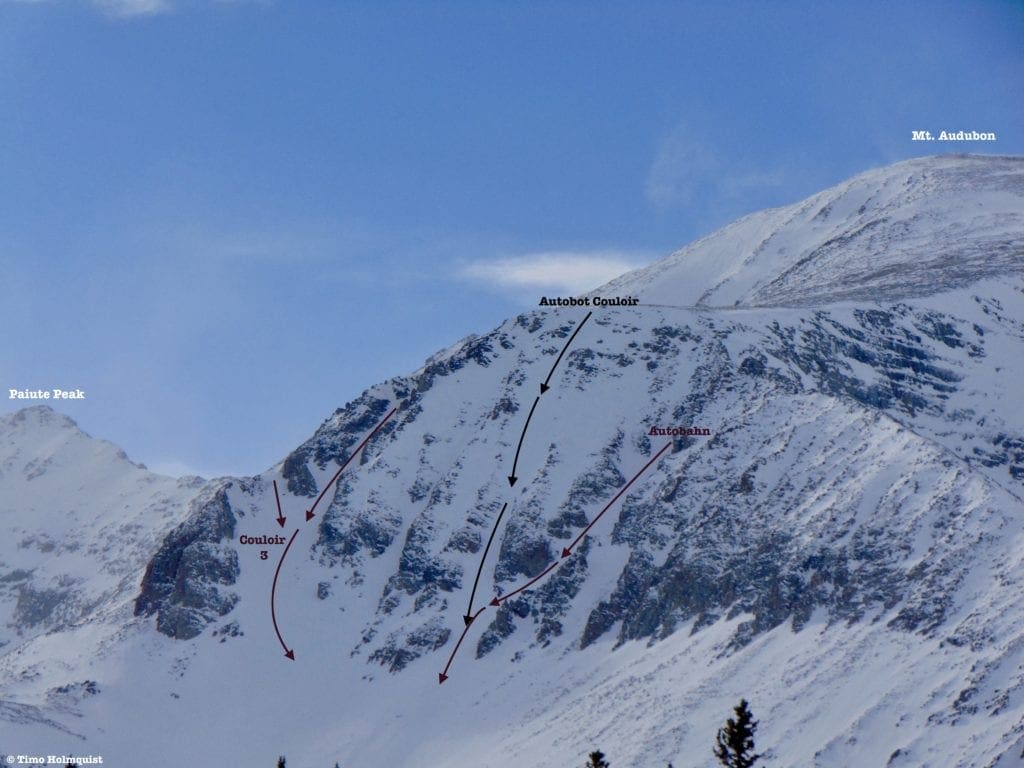
Autobahn Couloirs.
The Autobahn Couloir
- Essentials: 0.38 miles, ~1100 foot vertical
- Status: Difficult
- Steepest slope angle: 40 degrees
- Good for: Great, manageable couloir skiing, combinations with East Cirque and laps of the area. NOT for beginner skiers. Axe and spikes may be necessary if the couloir is hardpacked.
- Accessed via: Brainard Gateway Trailhead to Brainard Lake to Mitchell Lake Trailhead. From Mitchell Lake Trailhead proceed up the basin towards Mitchell Lake. Skirt the southside of the lake, or ski across if it’s frozen, and locate the obvious couloirs to the west of the lake and on the north rim of the basin. There will be three obvious couloirs, the one farthest right, and angling up into a notch in the ridge, is Autobahn. It is the easiest of the three.
- Couloir 3 Variation: Difficult. The unnamed couloir on the left (west) side is also quite manageable, and offers a slightly longer line than Autobahn. It is noticeable because of a hook to the right. This means the top of the couloir is not visible from Mitchell Lake.
- At a Glance: 0.4 miles, ~1150-foot vertical descent
- Steepest Slope: 45 degrees
- Autobot Couloir: Very Difficult. This is the monarch of the area and a heart-pumping descent. The couloir is the middle of the three couloirs. It is markedly steeper and shallower than its two neighbors, which means it melts out first. With a southeast aspect, make sure to hit it early and after a night where temperatures have dropped below freezing. NOT for beginner or intermediate skiers. Helmet, crampons, and axe may be necessary, evaluate terrain carefully before committing.
- At a Glance: 0.4 miles, ~1300 feet
- Steepest Slope: 50 degrees
- Couloir 3 Variation: Difficult. The unnamed couloir on the left (west) side is also quite manageable, and offers a slightly longer line than Autobahn. It is noticeable because of a hook to the right. This means the top of the couloir is not visible from Mitchell Lake.
Mt. Audubon: West Ridge. Owing to its complex structure, there is a third area of importance on Audubon. For the IPW faithful, both the South Face and the Crooked Couloir hold the crowns of most impressive ski descents on Audubon. It takes longer to get there, but the payoff is greater and the lines longer. Make sure you have a great weather day and get an early start; you will be logging some impressive mileage. There are two general ways to reach the couloirs: from the bottom, passing Mitchell and Blue Lake, or, from the top, summitting Audubon and making your way down the west ridge to the couloir entrances. If this is your first time in the area, bottom up always has the benefit of letting you assess the couloirs before committing.
- Stats to Lower Access: ~5.7 miles, ~1509 ft. of elevation gain
- Stats to Upper Access: ~7 miles, ~3221 ft. of elevation gain
- Subtract 3 miles and ~600 feet when the summer gate opens. Keep in mind, conditions after the gate opens are variable, expect to carry your skis and deal with slush. Don’t forget the $12 summer rec parking fee.
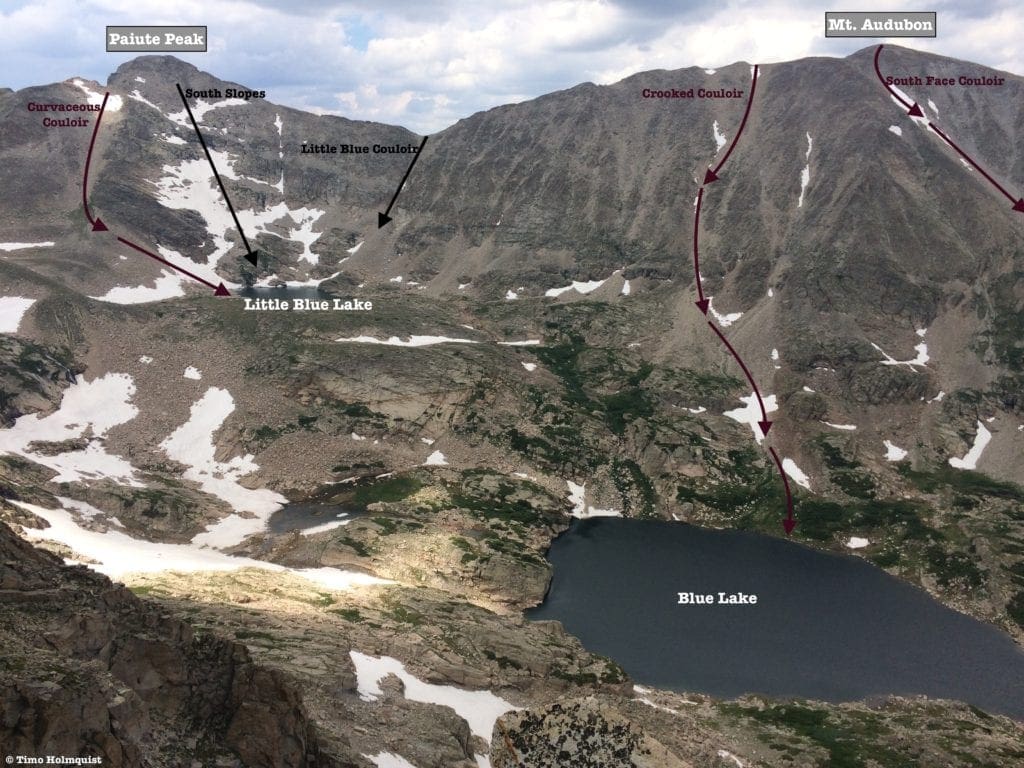
West Ridge Mt. Audubon.
- South Face Couloir
- Essentials: 0.71 miles, ~1880-foot vertical
- Status: Difficult
- Steepest slope angle: 45 degrees (brief)
- Good for: A summit descent in ideal conditions, though the bottom of the couloir melts out quickly in spring. Long and fairly mellow, the South Face is a great high elevation test piece. NOT for beginners due to its long approach and committing length. Bring friend and avalanche gear. Spikes, axe, and helmet highly recommended if climbing from bottom up. Bring strong terrain evaluation skills with you as well, especially if melting has exposed the terrain trap at the bottom of the couloir. Pronounced avalanche danger early in season; evaluate terrain carefully before committing.
- Accessed via: Audubon summit (see upper access stats), or Gateway Trailhead to Mitchell Lake to Blue Lake and then up the couloir. In either scenario, this is a 6.5-7-mile approach with 3200 feet of climbing. The approach is much shorter when the winter gate lifts but you may be carrying skis instead of skinning.
- Crooked Couloir
- Essentials: 0.58-miles, ~1750-foot vertical
- Status: Difficult
- Steepest slope angle: 43 degrees (brief)
- Good For: Skiing the most famous couloir on Audubon. Plan for a long day in the IPW with good company, good weather, and a full complement of avalanche gear. Slide risk is pronounced mid-winter, best skied in spring. Crampons, axe, and helmet may be necessary. NOT for beginners.
- Accessed via: Audubon summit, (see upper access stats). From the summit, proceed west 0.2 miles and locate the head of the couloir. Preferred method is Brainard Gateway to Mitchell Lake to Blue Lake. From Blue Lake, skirt north and find the couloirs runout on the lakes west edge. The approach is much shorter when the winter gate lifts, but you may be carrying skis instead of skinning.
Paiute Peak
This stately peak is connected to Audubon via the west ridge and sits right on the Continental Divide. It sports a series of desirable couloirs, the most famous being the Curvaceous Couloir. Many spots on Paiute tend to hold snow longer than Audubon due to its recessed position. Like Audubon, there are no beginner runs on it.
- Stats to Little Blue Lake (add distance and vertical for each run to calculate total): 6.3 miles, 2,102 ft. of gain
- Subtract 3 miles and ~600 feet of gain when the winter gate opens. Expect very variable conditions and ski carry’s over dry ground patches. Don’t forget the 12$ summer rec parking fee.
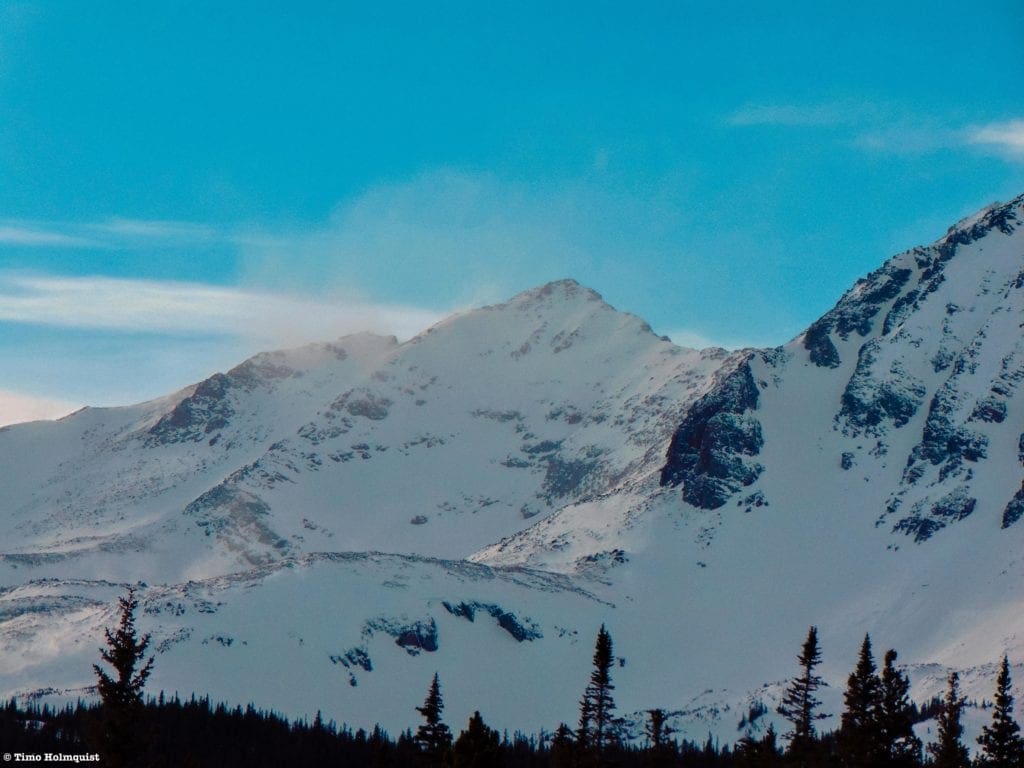
Paiute Peak from Brainard Lake with Autobahn Couloirs on the right.
- Little Blue Couloir
- Essentials: 0.2 miles, ~800-foot vertical
- Status: Very Difficult
- Steepest slope angle: 40-45 degrees
- Good for: Alpine couloir skiing surrounded by rock walls. The couloir itself doesn’t break 45 degrees, but the thin, quick nature of the descent means a fall could be fatal. NOT for anyone who isn’t a seasoned veteran of couloir skiing in remote terrain. Mountaineering equipment 100% necessary, along with avalanche gear early in season. Best skied in April-May.
- Accessed via: Gateway Trailhead to Mitchell Lake to Blue Lake. From Blue Lake, continue ascending towards the triangle shape of Paiute, eventually emerging at a small alpine lake, affectionately known as Little Blue Lake (or Upper Blue, it doesn’t have an official USFS name). From the lake, turn right and sight the low-point of the ridge between Audubon and Paiute. The rock-walled couloir is your goal; start climbing. Alternatively, you could hike up and over Audubon, but that approach is not recommended due to the likelihood of multiple ski carry’s.
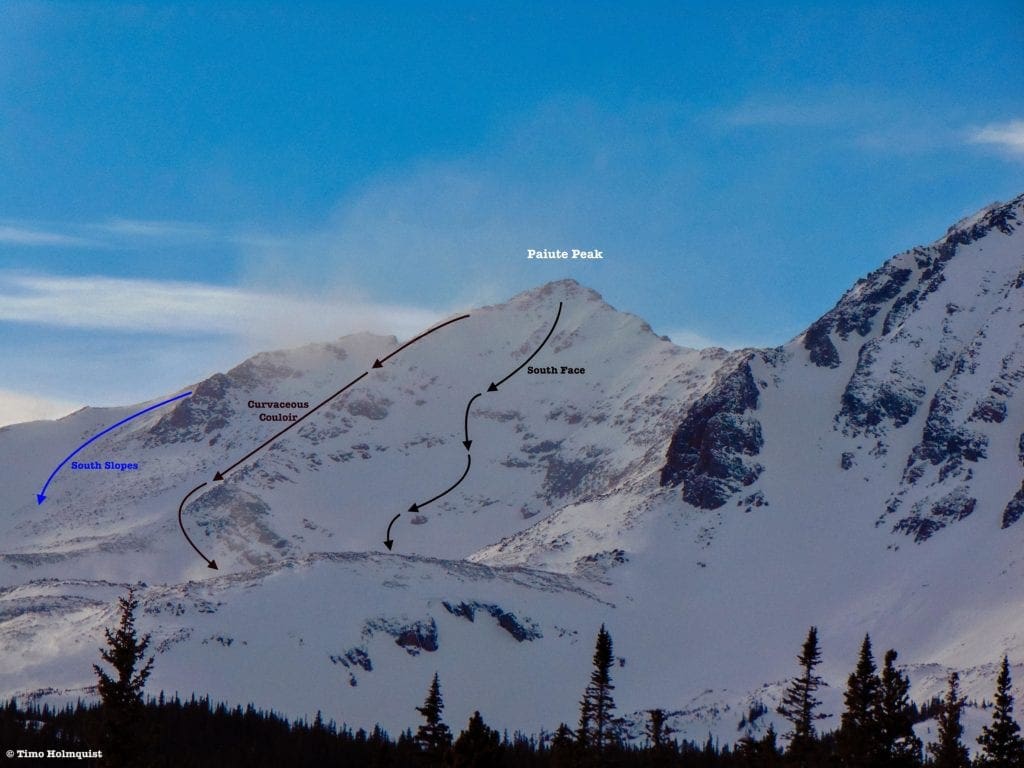
Paiute Ski Lines.
- Curvaceous Couloir
- Essentials: 0.71 miles, ~1880-foot vertical
- Status: Difficult
- Steepest slope angle: 45 degrees (brief)
- Good for: Another classic Indian Peaks descent and the standard descent from Paiute. The couloir gets a lot of sun in the first half of the day so hitting this one early is a must to avoid slushy turns and wet avalanche danger. NOT for beginners or intermediate skiers. Go with a partner and go with a full complement of avalanche gear.
- Accessed via: Brainard Gateway to Mitchell Lake to Blue Blake to Little Blue Lake. From the small lake above Blue Lake, you’ll be able to see the couloir curving towards the western side of the lake. Ascend the moderate pitch and note the couloir begin to curve northwards until hitting the ridge below the summit. Strap in, turn around and ski it down. The best bet for a continuous descent to below Blue Lake is to ski April-May, although in many years, the couloir is open through the first part of June.
- South Face Variation: VERY DIFFICULT. Although similar in slope and skiability as Curvaceous, Paiute’s South Face has the added complexity of multiple cliff bands that melt out first. A disaster scenario would be starting a wet slab avalanche due to arriving a little later on a warm day and having it send you over a cliff band. Evaluate terrain and weather CAREFULLY before attempting. Make sure the temperature dropped to below freezing the night before to help avoid wet avalanche danger. Avalanche and mountaineering gear are a must.
- At a Glance: 0.28 miles, 1100-foot vertical
- Steepest Slope: 45-50 degrees
- South Face Variation: VERY DIFFICULT. Although similar in slope and skiability as Curvaceous, Paiute’s South Face has the added complexity of multiple cliff bands that melt out first. A disaster scenario would be starting a wet slab avalanche due to arriving a little later on a warm day and having it send you over a cliff band. Evaluate terrain and weather CAREFULLY before attempting. Make sure the temperature dropped to below freezing the night before to help avoid wet avalanche danger. Avalanche and mountaineering gear are a must.
- South Slope
- Essentials: 0.5 miles, 900-foot vertical
- Status: Intermediate ski, Difficult Approach
- Steepest slope angle: 40 degrees (brief and usually avoidable)
- Good for: A great introduction to the Blue Lakes Basin. Although the hike/skin to get there is substantial, you’ll be able to sight almost every single line available in the basin, making it a great scouting trip mixed in with relatively low angle skiing from the Continental Divide. Bring a partner and a set of mountaineering tools. NOT for beginners due to distance traveled and remoteness.
- Accessed via: Gateway Trailhead to Mitchell Lake to Blue Lake to Little Blue Lake. Proceed west from Little Blue Lake, passing the bottom of the Curvaceous Couloir and a rock rib before hitting a higher bench. From here, the head of the basin should be directly in front of you, turn to the right (towards Paiute), and locate a mellow, wider slope that will take you up to the ridge line. Go as high as the snow lets you, strap in, and turn around.
- Bonus: Combo with approach route. In perfect conditions, the line will take you all the way past Mitchell Lake for a total of ~3.5 miles and ~2300 feet of skiing from the top of the South Slope.
Mt. Toll
Although both Audubon and Paiute are taller, once you get a view of Mt. Toll, it’s hard to take your eyes off of it. The precipitous North Face and stately summit give rise to mountain fantasies almost instantly. Its position at the head of the Blue Lakes Basin makes it a desirable target for any season, and luckily, there is a great way to ski it from the summit.
- Stats to bottom of ski line: 5.7 miles, 1,509-foot gain (add Tollway stats to get total amounts).
- Subtract 3 miles and ~600 feet when the winter gate opens. Expect variable conditions and ski carry’s over dry ground patches. Don’t forget the 12$ summer rec parking fee.
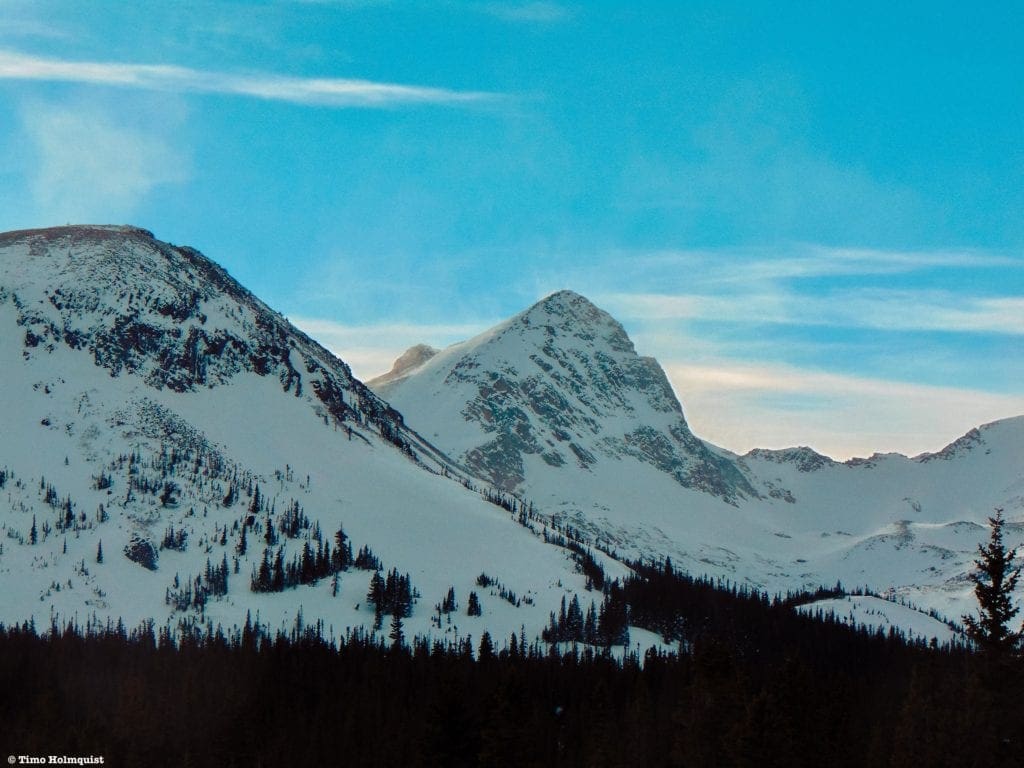
Mt. Toll from Brainard Lake
- Tollway
- Essentials: 0.5 miles, 1624-foot vertical
- Status: Difficult
- Steepest slope angle: 42 degrees (brief)
- Good for: Skiing arguably the most famous line in this area of the IPW. Toll is a magnet for front range skiers and will be crowded on weekends. The distance and effort are substantial. Toll also holds snow late into the season, making June descents possible. Bring a full complement of mountaineering gear and avalanche gear if attempting. NOT for beginners.
- Accessed via: Brainard Gateway to Mitchell Lake to Blue Lake. From Blue Lake, skirt south or ski across the lake, located a weakness in a low cliff band due west. Ascend to a flatter benched area. To the left of the dominant Mount Toll, find the path of least resistance, gaining elevation until you reach the north saddle between Toll and Pawnee Peak. From there, turn right and ascend up the steeper part of the mountain. Here, spikes may be necessary. Summit, strap in, turn, and descend.
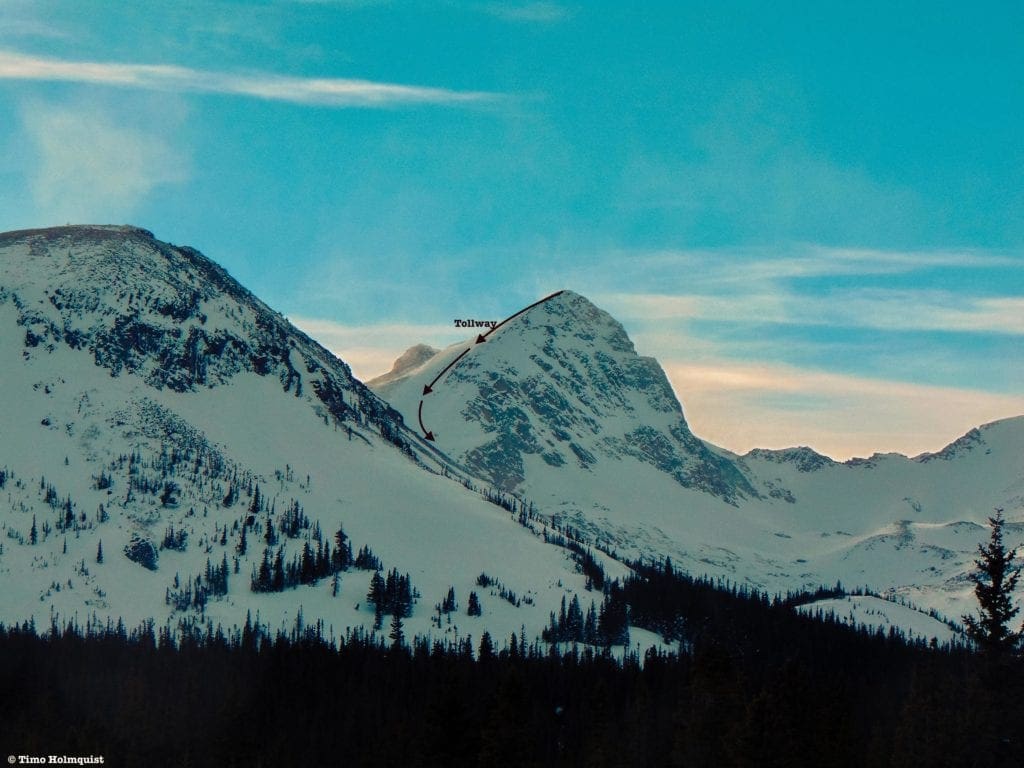
Tollway ski run on Mt. Toll.
Pawnee Basin
Pawnee Basin is right in the middle, Blue Lakes to the North, Isabelle to the south. It shares the same approach with Isabelle Basin, right up to the shores of Lake Isabelle. From the lake, a hard right will get you into Pawnee Basin, while continuing west around the lake will take you towards Isabelle Glacier, Apache Peak, and Navajo Peak. Geographically, Pawnee Basin is a sub-area of Isabelle, but enough ski line variety exists here to warrant its own section. Generally speaking, the lines here are more mellow than Blue Lakes to the north, although fantastic and challenging couloir skiing exists here as well.
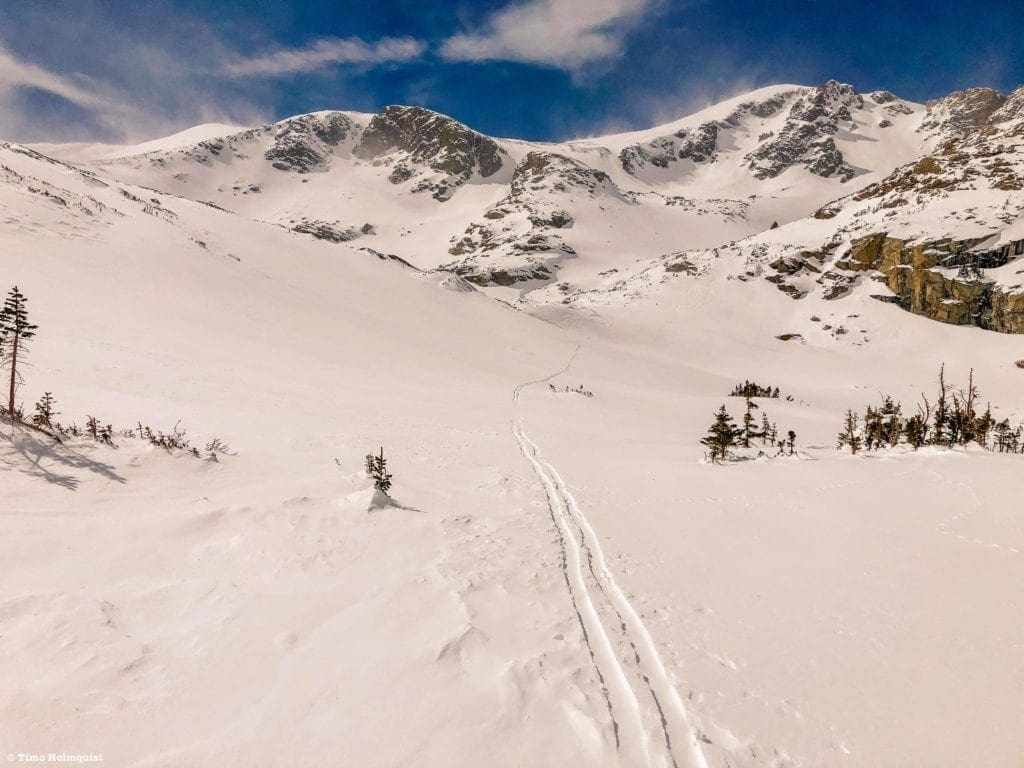
Photo of Pawnee Basin.
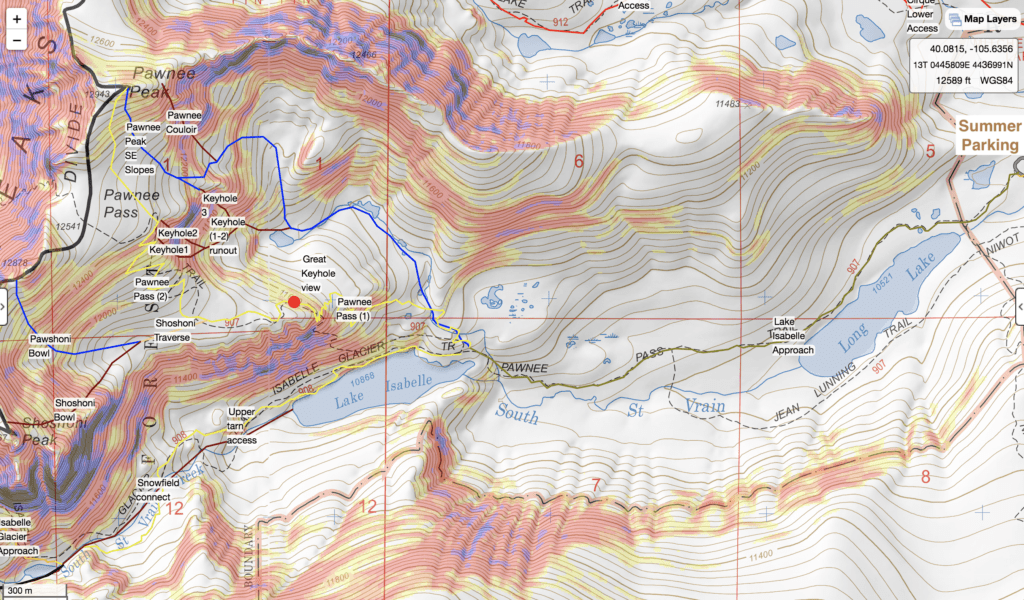
Pawnee Basin Map.
Pawnee Peak
While just about the same height as its dramatic neighbor Mt. Toll, Pawnee is more of a reclusive lump, only visible once you enter the basin. Its rounded top and wide-open southeast face yield some of the best moderate skiing in the region. It also sports one of the finest couloir runs accessible from Brainard.
- To Pawnee Peak Summit (snow route): ~6.7 miles, ~3,052 ft. elevation gain
- To Pawnee Peak Summit (Pawnee Pass Trail): ~7.64 miles, ~3,052 ft. elevation gain
- To top of Keyholes (Pawnee Pass Trail): ~7.18 miles, ~2,586 ft. elevation gain
- Subtract 3 miles and ~600 feet of gain when the winter gate opens. Expect variable conditions and ski carry’s over dry ground patches. Don’t forget the $12 summer rec parking fee.
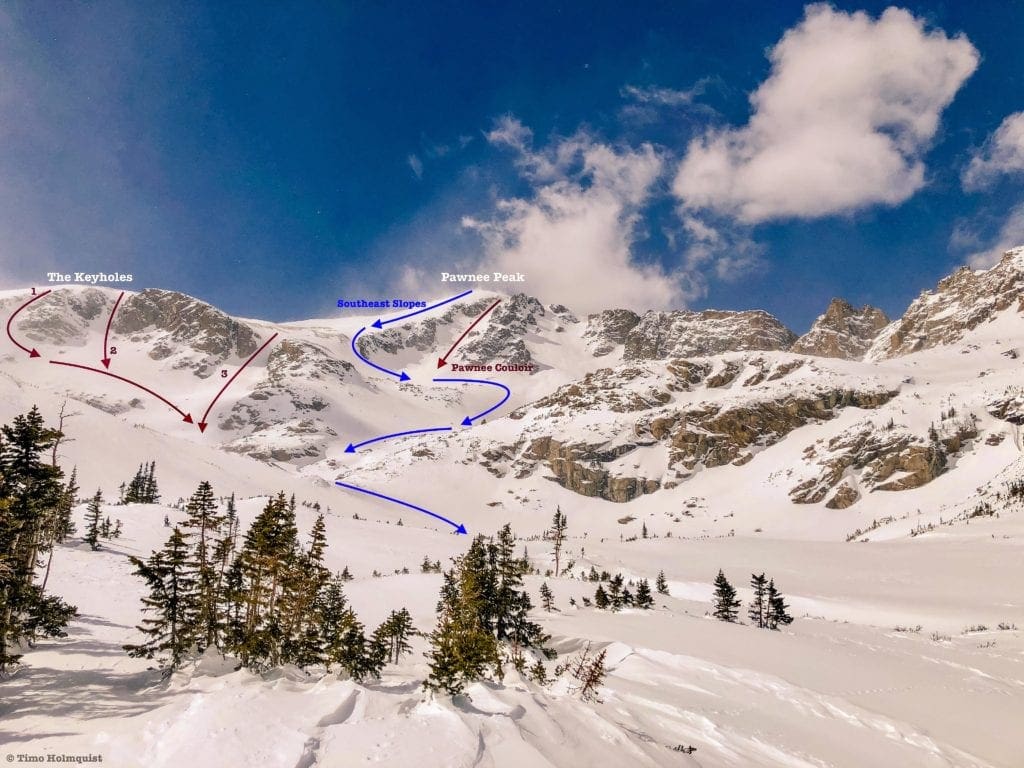
Pawnee Peak photo with Southeast Slopes and Pawnee Couloir visible.
- Southeast Slopes
- Essentials: 1.67 miles, ~2020-foot vertical
- Status: Intermediate skiing, Difficult approach
- Steepest slope angle: 38 degrees (brief)
- Good for: Getting to ski from the summit of a major mountain in relatively mellow conditions. In spring, this is a 2000-foot descent to Lake Isabelle and possibly a couple hundred feet more to the marsh above Long Lake. While the route doesn’t slide often, you pass underneath avalanche-prone areas, avvy gear and good company are highly recommended.
- Accessed via: Brainard Gateway Trailhead to Long Lake to Lake Isabelle. From just east of Lake Isabelle’s shore, turn right (north) and sight the entrance to Pawnee Basin. Work your way north, following the bottom of the basin as it leads you by three alpine tarns, one higher than the other. After the third tarn, continue north up the bottom of the basin. Before getting to the basin headwall, turn left and sight a manageable ramp leading southwest. Perform an ascending traverse and when feasible, turn back north on a wide-open slope to the summit of Pawnee. Turn and descend the ascent route. It is possible to ascend via Pawnee Pass when snow is lacking, but the approach is longer.
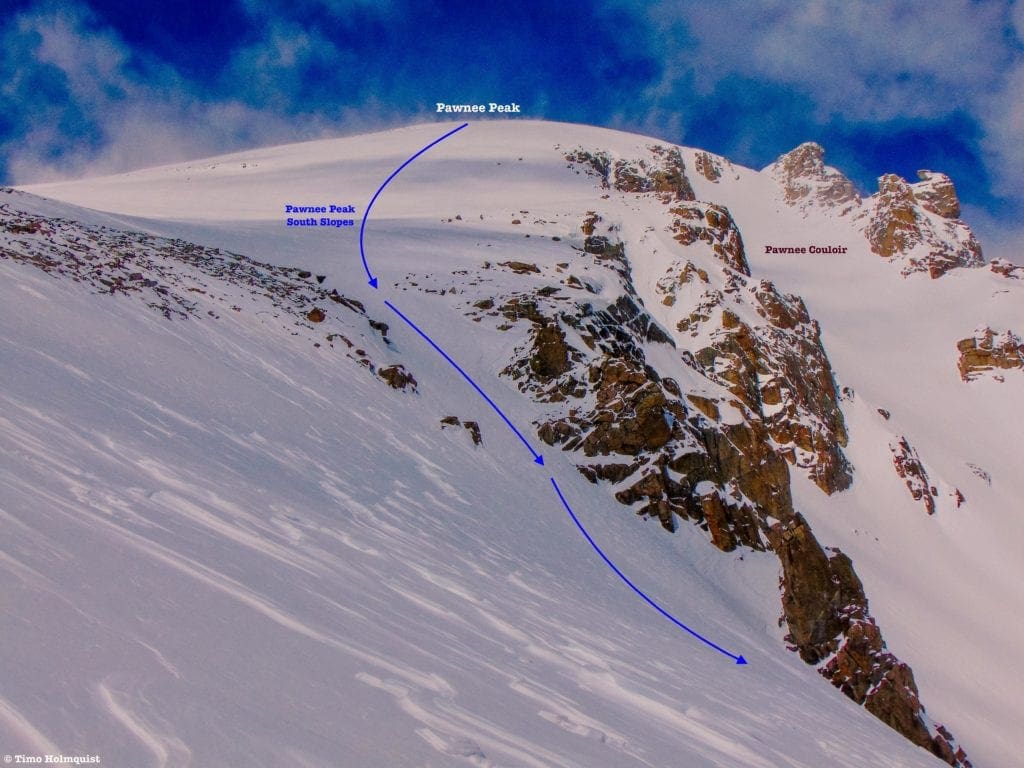
Upper Southeast Slope Route.
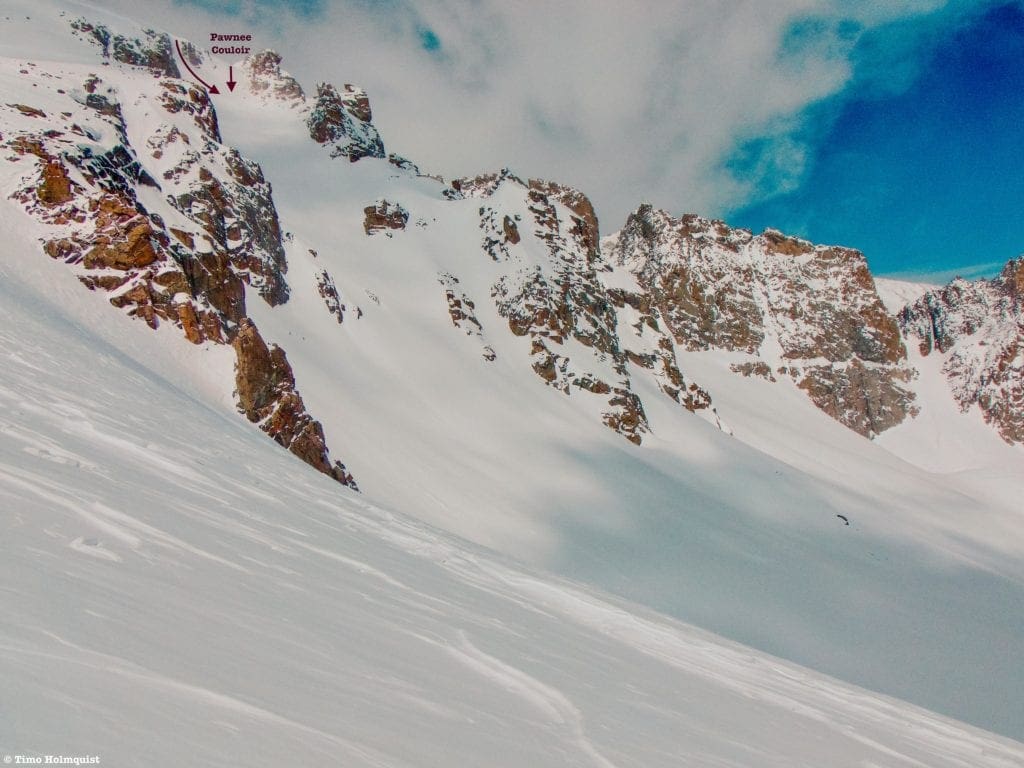
Pawnee Couloir with both entrances marked.
- Pawnee Couloir
- Essentials: 0.27 miles, 850-foot vertical (if coverage exists to Lake Isabelle: ~1.48 miles, 1862-foot vertical).
- Status: Difficult
- Steepest slope angle: 45 degrees
- Good for: Sublime couloir skiing, an IPW classic, and often overlooked. The couloir does receive early morning sun so get after it early. There are some rocks that melt out as the season continues, and the couloir entrance steepens and narrows as the snow retreats. April is ideal. Avalanche danger is high earlier in the season, and mountaineering gear is necessary to climb the couloir. However, you can use the SE slopes to climb to the top without an axe; make sure you assess the conditions from the bottom of the couloir before committing. NOT for beginners.
- Accessed via: Brainard Gateway to Long Lake to Lake Isabelle. Turn right and climb into the Pawnee Basin following a string of alpine tarns. After the last tarn, continue climbing north until sighting a SW ramp leading left. From here, you pass the bottom of the couloir, assess conditions. You can climb the couloir directly or continue on the SE slopes ramp, finding Pawnee’s summit and then easing east until reaching the top of the couloir.
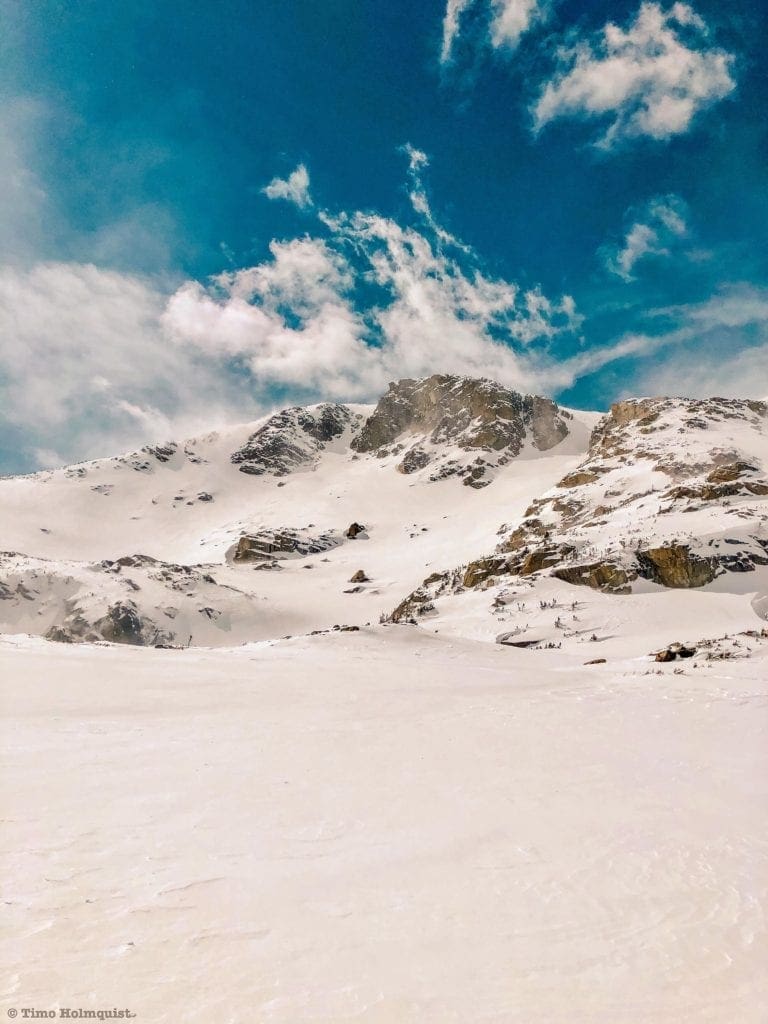
The Keyholes (all 3 visible).
- The Keyholes: These three short couloirs can add some spice to a Pawnee Day. It is possible to connect the summit of Pawnee with Keyhole 3 (the farthest east, or climbers right). The description below is for Keyhole 3, with the others listed as variations below.
- Essentials: 0.29 miles, 760-foot vertical (combined with Pawnee Peak: 1.45 miles, ~2000 feet)
- Status: Difficult
- Steepest slope angle: 43 degrees (brief)
- Good for: Lapping the three Keyholes, combining with either Pawnee Peak or Pawshoni. There is significant slide potential in mid-winter; bring proper avalanche gear and friends. NOT for beginners.
- Accessed via: Brainard Gateway to Long Lake to Lake Isabelle. Turn north (right) and climb into Pawnee Basin, stay lower than the summer trail and follow the three tarns up the basin. Above the last tarn (still heading north), find a SW angling ramp passing the bottom of Pawnee Couloir. Climb up to a flat bench with the mellow upper slopes of Pawnee above you, turn south and find the entrance to the couloir (it will be slightly below you). Alternatively, continue to Pawnee’s summit and try to ski the connection. The Keyholes are also attainable via the Pawnee Pass trail, which heads left of the snow route up a prominent ridge. From this ridge, the Keyholes are very obvious to your right.
- Keyhole 2 Variation: Difficult/Very Difficult. When climbing towards them, Keyhole 2 is to the left of the prominent rock rib. It is skinner and steeper than Keyhole 3. There is an exposed rock outcropping near the entrance.
- At a Glance: 0.15 miles, 625-foot vertical (to Lake Isabelle: 1.18 miles, 1,420-foot vertical).
- Steepest Slope Angle: 49 degrees (brief)
- Keyhole 1 Variation: Difficult. This the westernmost possible variation. Climbers left, skiers right.
- At a Glance: 0.2 miles, 650-foot vertical (to Lake Isabelle: 1.23 miles, 1446-foot vertical).
- Steepest Slope Angle: 46 degrees (brief)
- Keyhole 2 Variation: Difficult/Very Difficult. When climbing towards them, Keyhole 2 is to the left of the prominent rock rib. It is skinner and steeper than Keyhole 3. There is an exposed rock outcropping near the entrance.
Shoshoni Peak
Shoshoni is an impressive peak; towering over Lake Isabelle and containing a short airy scramble to its summit. There is a large bowl on its northern side that provides some excellent turns. Further to the north, the subpeak of Pawshoni has another wide bowl for even more exploration. There is NO exit at the bottom of the bowls because it cliffs out, traverse back to Pawnee Pass Trail to leave the area.
- To bottom of Shoshoni/Pawshoni Bowls: ~6.62 miles, ~2,090-foot gain (add stats for each bowl to calculate total gain and mileage).
- Subtract 3 miles and ~600 feet when winter gate opens. Keep in mind, conditions after the gate opens are very variable, expect to carry your skis and deal with slush. Don’t forget the 12$ summer rec parking fee.
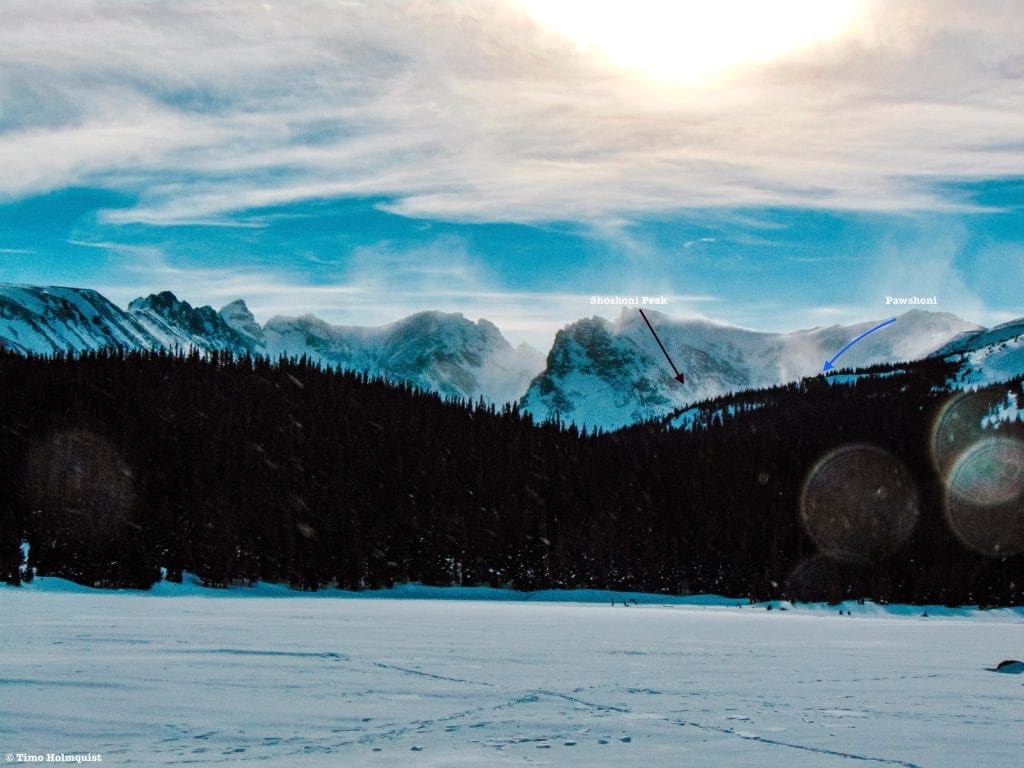
Shoshoni Peak from Brainard with Pawshoni.
- Pawshoni Bowl
- Essentials: 0.49 miles, 1000-foot vertical
- Status: Intermediate
- Steepest slope angle: 38 degrees
- Good for: High elevation laps in a wide bowl, combination with Shoshoni and the keyholes. Bring helmets and mountaineering equipment, the middle of the bowl is thinner because of wind, watch for rocks and exposed hazards. Ideal in April/May. NOT for beginners.
- Accessed via: Brainard Gateway to Long Lake to Isabelle Lake. Turn right (north) and enter the Pawnee Basin. Follow the Pawnee Pass summer trail up a ridge to the left, using the Keyholes to your right as markers. Once you reach a bench at just over 11,800, leave the approx. route of Pawnee Pass Trail and head west. Shoshoni and Pawshoni will be visible in front of you. Find the bottom of the bowls and work your way up as high as you can go. Alternatively, stay with the Pawnee Pass Trail until the pass, take a left, and ridge hop to Pawshoni and Shoshoni. Remember there is no exit down to Lake Isabelle from the bottom of the bowls; traverse back to Pawnee Pass Trail.
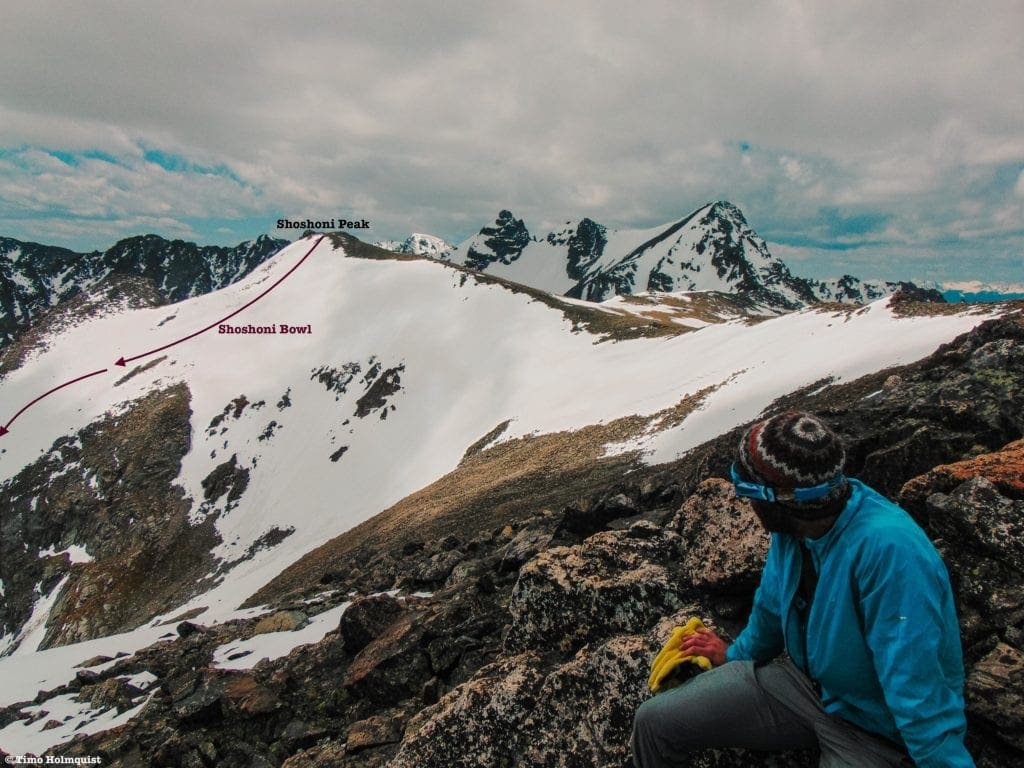
Shoshoni Peak and Shoshoni Bowl from Pawshoni.
- Shoshoni Bowl
- Essentials: 0.48 miles, 1076-foot vertical
- Status: Difficult
- Steepest Slope Angle: 41 degrees
- Good for: High elevation laps in a wide bowl, combination with Pawshoni and the keyholes. Slightly steeper than Pawshoni. Bring helmets and mountaineering equipment, like Pawshoni the middle of the bowl is thinner because of wind, watch for rocks and exposed hazards. Ideal in April/May. NOT for beginners.
- Accessed via: Brainard Gateway to Long Lake to Isabelle Lake. Turn right (north) and enter the Pawnee Basin. Follow the Pawnee Pass summer trail up a ridge to the left, using the Keyholes to your right as markers. Once you reach a bench at just over 11,800, leave the approx. route of Pawnee Pass Trail and head west. Shoshoni and Pawshoni will be visible in front of you. Find the bottom of the bowls and work your way up as high as you can go. Alternatively, stay with the Pawnee Pass Trail until the pass, take a left, and ridge hop over to Shoshoni. Remember there is no exit down to Lake Isabelle from the bottom of the bowls; traverse back to Pawnee Pass Trail.
Isabelle Basin
Of the three basins covered in this article, Isabelle is, in my opinion, the most dramatic. The scenery is absolutely spectacular, and the ski lines are epic. The only detractor is the added effort to get there, especially from the Brainard Gateway Trailhead. Plan for a long day, and start early. Because this basin is tucked back into the divide, snow exists through June, and the area can be lapped after the winter gate opens.
- To unnamed tarn below route convergence: ~6.65 miles, ~1,853-foot gain (add stats for each line to calculate total gain and mileage).
- Subtract 3 miles and ~600 feet when winter gate opens. Keep in mind, conditions after the gate opens are very variable, expect to carry your skis and deal with slush. Don’t forget the 12$ summer rec parking fee.
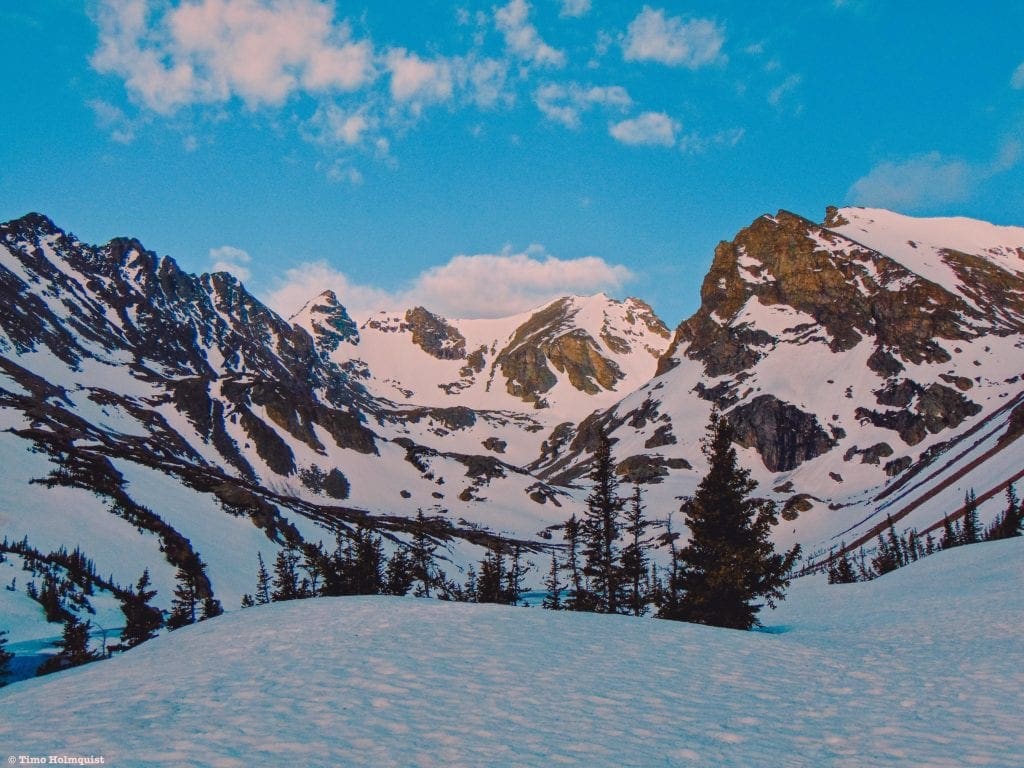
Looking west to Navajo Peak and Apache Peak from Lake Isabelle
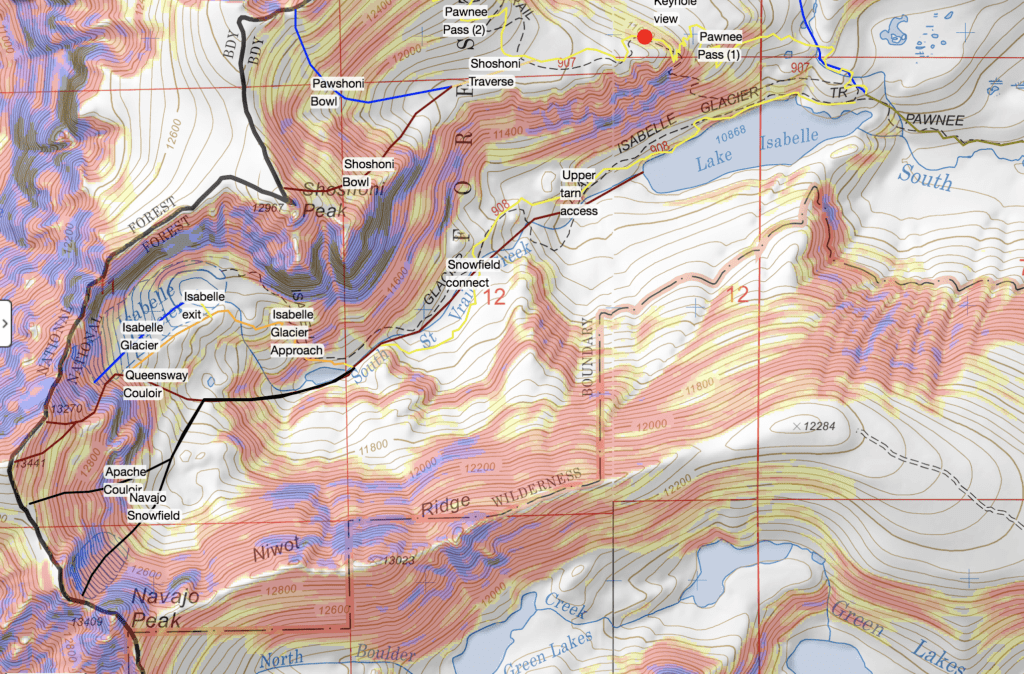
Isabelle Basin Map
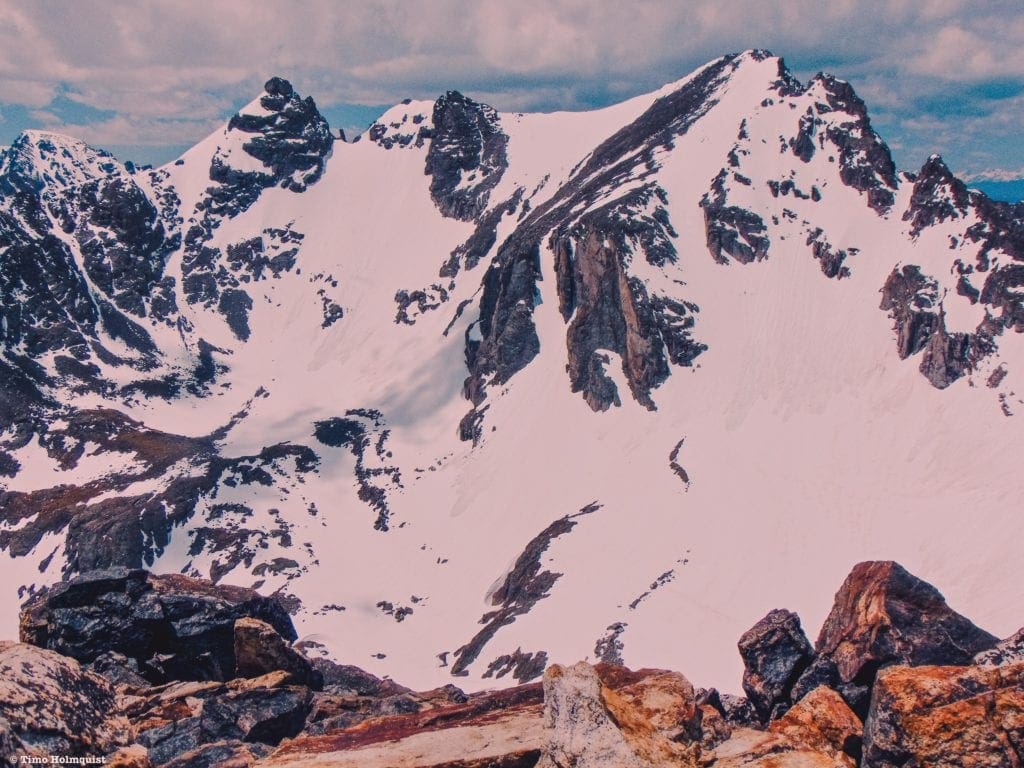
Isabelle Basin from Shoshoni Peak
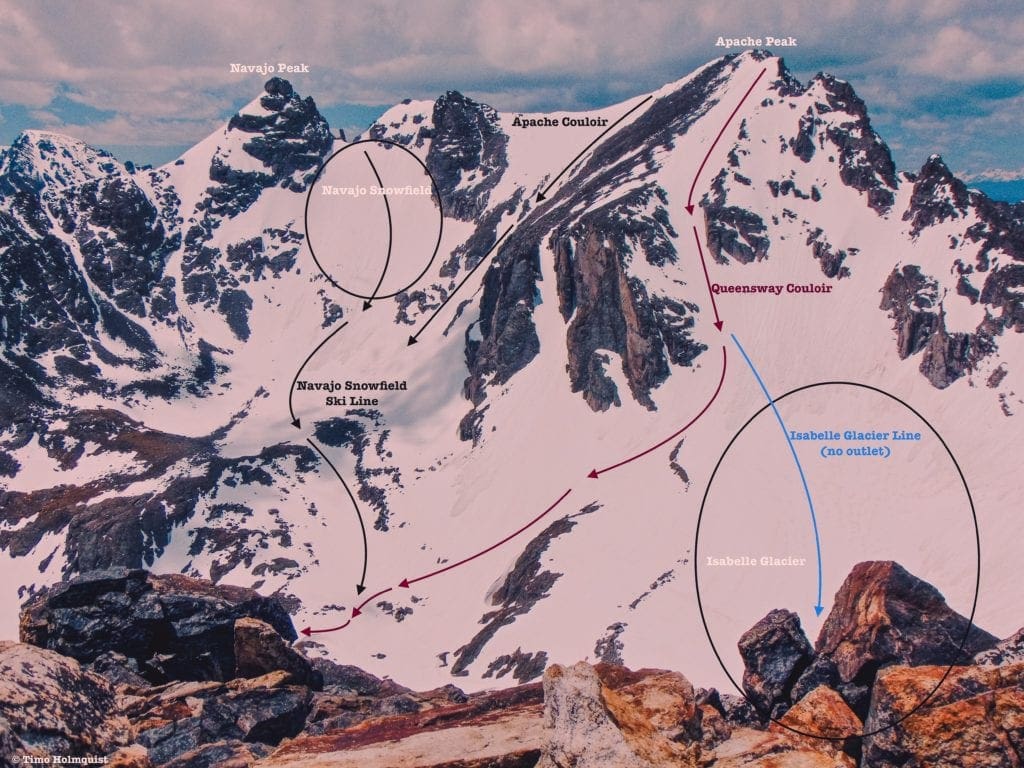
Isabelle Basin ski lines from the top of Shoshoni Peak.
Apache Peak
- Queensway Couloir: This magnificent couloir is visible from Brainard Lake and Lake Isabelle. In great spring snow (April-May), you can ski from the summit all the way down to a small tarn and then connect snowfields back to Lake Isabelle. The line is described from a sub summit where snow connection is most likely; a summit variation is listed below it.
- Essentials: 0.79 miles, 1875-foot vertical (In June when the top melts out: 0.5 miles, ~1200-foot vertical).
- Status: Difficult
- Steepest Slope Angle: 40 degrees
- Good for: Dedicated backcountry enthusiasts looking to ski from the top of a large mountain and down a broad, well-defined couloir. Through April, avalanche gear is a must. Mountaineering gear is also exceptionally helpful when climbing the couloir. Evaluate conditions carefully before committing. NOT for beginners.
- Accessed via: Brainard Gateway to Long Lake to Lake Isabelle. From Isabelle, continue across or around the lake (right/north side), continuing up the valley to a small tarn at the base of the final basin. Climb directly west up a steep slope to a bench. From the bench, angle your climb West-North West (slight right), keeping intimidating cliffs to your left. When the cliffs break, you should be able to stare up the couloir, ascend as high as you can. Alternatively (and highly recommended if this is your first time in the area), at the small tarn, climb a steep slope to your right, eventually reaching the rim of Isabelle glacier. Turn left and ascend easy slopes to the bottom of the couloir, which is now in full view and can be assessed by your party.
- Summit Variation: Difficult. In April or early May, it is possible to ski directly from the summit of 13,441-foot Apache Pk., the tallest peak accessible from Brainard and the second tallest in the Indian Peaks.
- At a Glance: 0.9 miles, 2,017-foot vertical. (With the exception of 1-2 small melted out areas, it is possible to ski down to Lake Isabelle for a grand total of 1.71 miles, 2572-foot vertical).
- Steepest Slope Angle: 40 degrees
- Isabelle Glacier Variation: Intermediate. Using either access route described above, arrive at the base of the couloir and climb to just below the rock walls framing the right side of the couloir. Strap in and ski down the glacier; this is a great area for multiple laps.
- At a Glance: 0.3-miles, 600-foot vertical
- Steepest Slope: 40 degrees (easily avoidable), mostly 20-25 degrees with a small spot of 30.
- Summit Variation: Difficult. In April or early May, it is possible to ski directly from the summit of 13,441-foot Apache Pk., the tallest peak accessible from Brainard and the second tallest in the Indian Peaks.
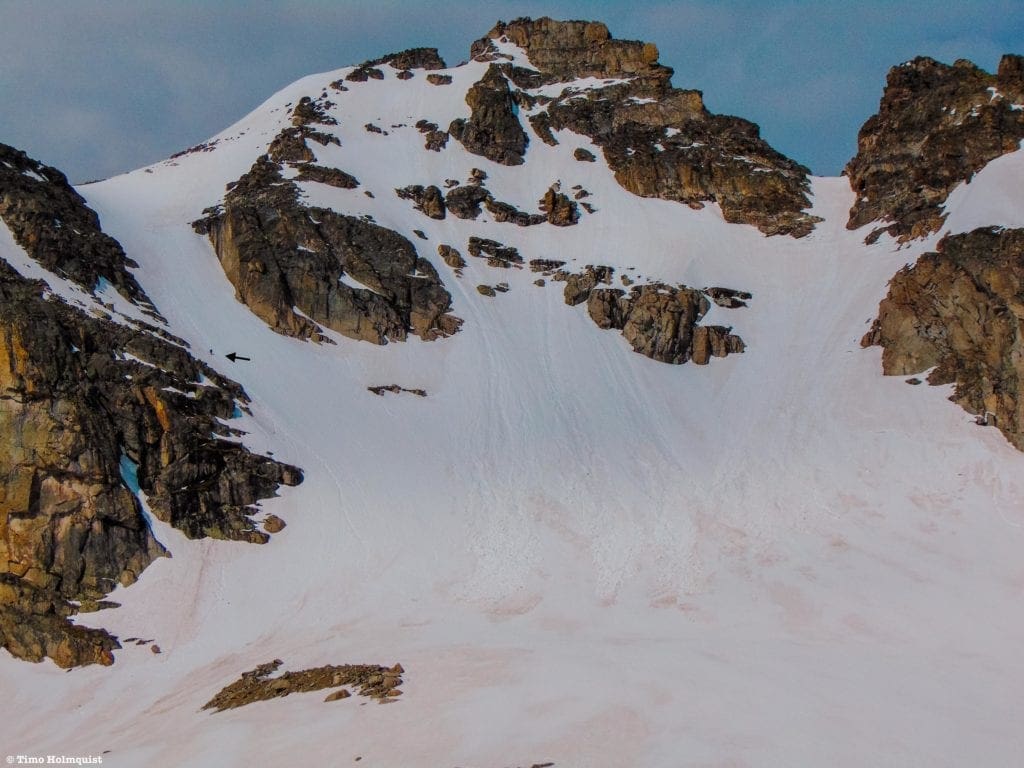
Queensway Couloir from the edge of Isabelle Glacier: You can see a mountaineer in the bottom left portion of the couloir.
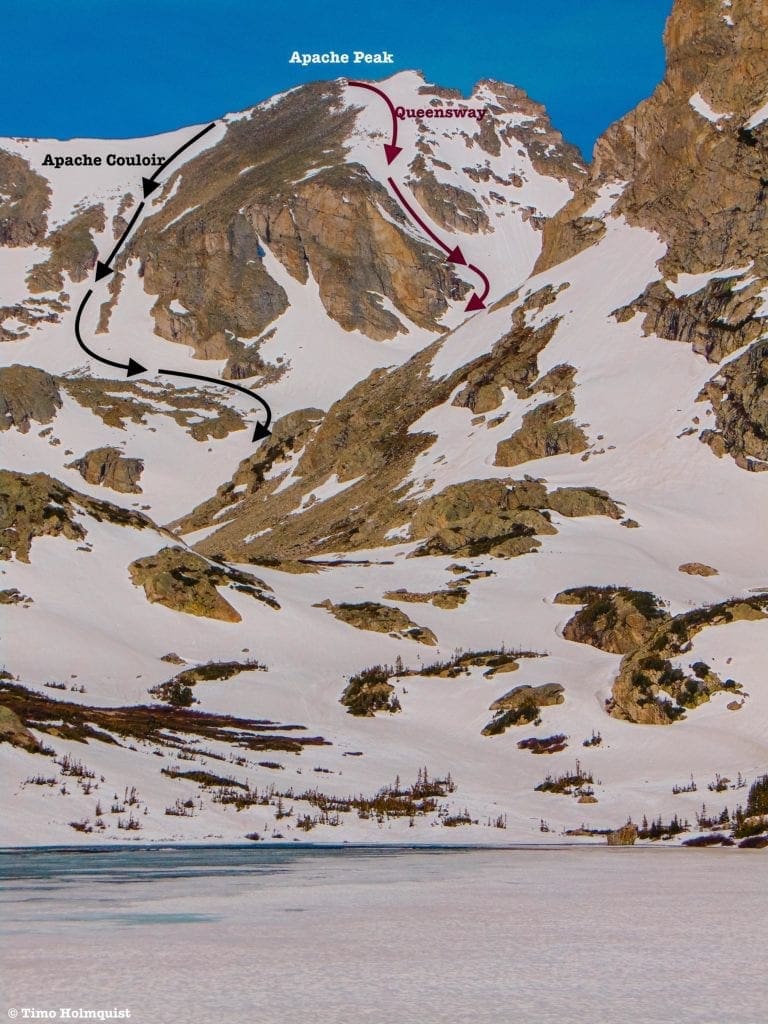
Apache Couloir from Isabelle Lake.
- Apache Couloir
- Essentials: 0.86 miles, 1830-foot vertical
- Status: Very Difficult
- Steepest Slope Angle: 45 degrees
- Good for: A challenging variation on Apache. The couloir is steeper and thinner than Queensway. Later in the season, the snow melts near the ridgeline, shortening your descent. An early May ascent in good conditions would be ideal though the main couloir holds snow well into June. NOT for beginners. Skiers should be prepared for variable conditions, bring a full complement of avalanche gear and mountaineering equipment.
- Accessed via: Brainard Gateway to Long Lake to Lake Isabelle. From Isabelle, continue across or around the lake (right/north side), continuing up the valley to a small tarn at the base of the final basin. Climb directly west up a steep slope to a bench. From the bench, angle your climb SW around the rocky bulk of Apache Peak until the bottom of the couloir comes into view. Climb up and ski down.
Navajo Peak
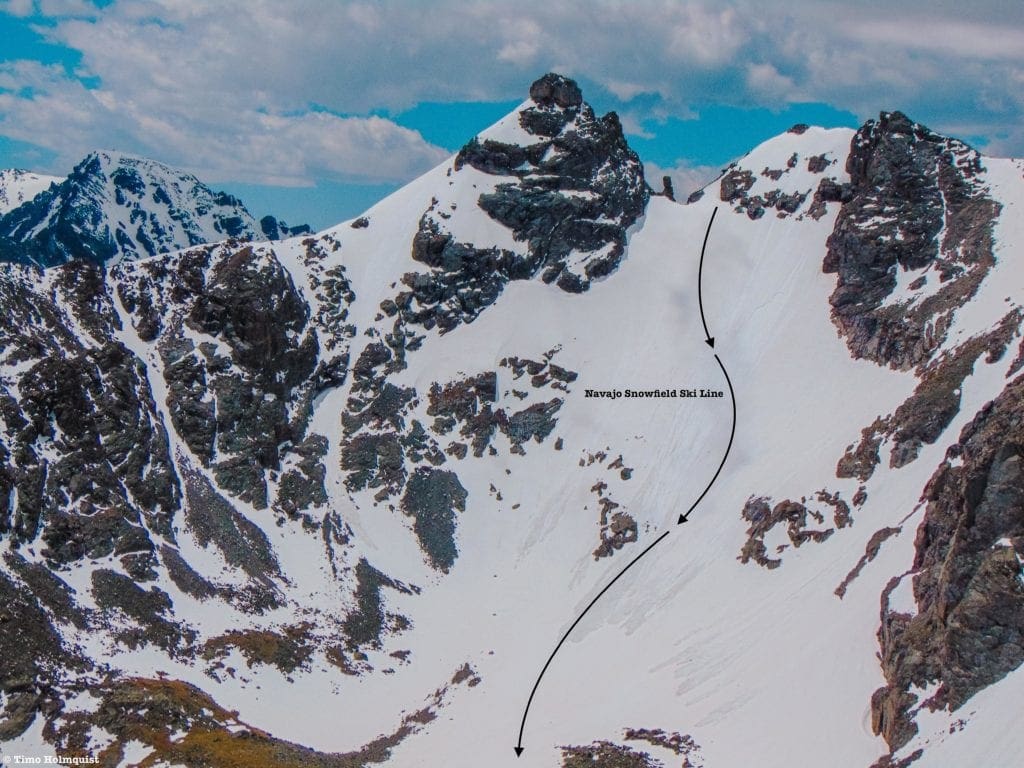
Navajo snowfield ski line.
- Navajo Snowfield
- Essentials: 0.48 miles, 1731-foot vertical (up to 2,000 ft depending on how far down the valley you can ski).
- Status: Very Difficult
- Steepest Slope Angle: 47-50 degrees
- Good for: Consistent and steep snow, with a beautiful descent. Hazards exist on this route. A crevasse can form on skiers left (north) as summer progresses, additionally, black ice forms on skiers right (south) and spreads to the whole snowfield by fall. The ideal ski season for this line is spring-early summer. Mountaineering gear, avalanche gear, and a partner are mandatory. NOT for beginners or intermediate skiers.
- Accessed via: Brainard Gateway to Long Lake to Lake Isabelle. From Isabelle, continue across or around (right/north side) the lake, continuing up the valley to a small tarn at the base of the final basin. Climb directly west up a steep slope to a bench. From the bench turn south and sight the snowcone top of Navajo Peak. Navajo’s summit guards the left edge of the snowfield, while an unnamed sub-peak guards the right. Choose your line and ascend, generally speaking, climbers left is a little mellower, but this is a very difficult route regardless.
Terminology Reference Guide:
- Apron: An open section of a ski line, shaped roughly like an apron. It is generally shallower at the top, wider at the bottom.
- Bootpack: A way to gain elevation utilizing the tough exterior of ski boots, literally creating steps in the slope with your ski boots. Only effective in mid-winter conditions with softer snow. Once ice forms, crampons, and an axe are best.
- Bergschrund: Unlike a crevasse, which tends to form in the middle of a glacier, a bergschrund, or “schrund” for short is a crack or separation that forms between the top of a glacier and the mountain slope or stagnant snow behind it.
- Black Ice: A transparent coating of ice, hard to see and very slick.
- Chute: An inset area along a ridge that can hold great snow and presents like a natural ski run.
- Cirque: an amphitheater shaped head of a glacial valley, usually steep.
- Cornice: An overhung area of snow that typically forms at the crest of a ridge or cirque. While the corniced ice and snow looks compact, there is usually nothing holding it up underneath; your weight alone can collapse a cornice. A collapsed cornice may also lead to avalanches. Do not stand on the edge of a cornice or climb directly beneath one.
- Couloir: Originally a French alpinist term, a couloir is a thin, steep, skiable chute. They are typically a no fall zone and challenging to ski effectively.
- Crevasse: A large crack that usually forms on glaciers during warmer times of year as the compact ice shifts. Very dangerous if fallen into.
- Crown: The vertical fracture line that appears after a slab avalanche, indicative of unstable terrain.
- Crux: Typically, the most dangerous section of an ascent or descent. Difficult routes can have multiple cruxes. A NO FALL ZONE.
- Glade: A treed area of a particular slope or line.
- Headwall: A topographical term used to mark where a basin, gorge, or alpine valley ends. Headwalls are usually steep and can sport multiple couloir options.
- Line: The chosen path of skiers and snowboarders.
- Runout: The bottom of a ski line, especially after a thin section or couloir, where the slope opens up. Similar to an apron.
- Skin track: The route you use to ascend a slope, very important for backcountry navigation.
- Terrain Trap: An area where snow from an avalanche can collect and bury a victim. More broadly an area where it is difficult to ski out of once entered.
- Wind-Slab: An area of compacted snow: formed by gusty winds. If near a steep slope, they can collapse and cause avalanches. Wind-slabs are often called wind-loaded slopes as well.
Final Thoughts
Brainard has long been one of my go-to locations for backcountry skiing. It is not the easiest place to get into backcountry (especially if the winter gate is closed) but the rewards speak for themselves. I’ve often found untracked powder and mountain majesty between the three basins discussed in this article. It truly is a wonderful place. If you’re ready to step up your backcountry game and really earn your turns, considering exploring Blue Lakes, Pawnee and Isabelle Basins.
As always, tie your adventures to safety. If the local knowledge is lacking, weather is threatening, or you have an unfavorable avalanche forecast, consider venturing out at a different time. The mountains will still be there when you return, and successful risk management allows us to enjoy them year after year. Be safe and have a blast out there!
Resources:
AIARE, Avalanche Research Education. (n.d.)
Allenspark Lodge Bed and Breakfast. (2014)
Colorado Avalanche Information Center. (n.d.)
Colorado University. Mountain Research Station. (n.d.)
- Niwot Ridge Weather. (n.d.)
doubleA. 2010. Skiing the Crooked Couloir.
VisitEstesPark.com. (2021). Lodging.
Front Range Ski Mountaineering. (n.d.)
Mountain Forecast. (n.d.)
National Weather Service
- Allenspark Extended Forecast. (n.d.)
Dawson, Lou. 2019. Rating Ski Descents-D System.
National Weather Service
- Brainard Lake Extended Forecast. (n.d.)
Sunshine Mountain Lodge. (2021)
USDA: Natural Resources Conservation Service, National Water and Climate Center. (n.d.) Snotel Interactive Map.
Villaceran, Marie. (2020). Top 3 Cool and Unusual Hotels in Nederland.
-
Backcountry Skiing in the Indian Peaks Wilderness: St. Vrain Area
-
Backcountry Skiing in Rocky Mountain National Park: Hidden Valley and Sundance Mountain Ski Lines
-
Backcountry Skiing in Rocky Mountain National Park: Bear Lake Area Ski Lines
-
Backcountry Skiing in Rocky Mountain National Park: Longs Peak Area Ski Lines
-
Best Places To Backcountry Ski in Rocky Mountain National Park, Colorado: Best of the Rest
-
Remote Backcountry Ski Lodges in British Columbia
-
Introduction to Backcountry Skiing
SKYBLUEOVERLAND.com, should you choose to go backcountry skiing, do so at your own risk. Prior to setting out check current local weather, conditions, and land/road closures. While taking a trail, obey all public and private land use restrictions and rules, carry proper safety and navigational equipment, and of course, follow the #leavenotrace guidelines. The information found herein is simply a planning resource to be used as a point of inspiration in conjunction with your own due-diligence. In spite of the fact that this guide was prepared under diligent research by the specified contributor and/or contributors, the accuracy of such and judgement of the author is not guaranteed. SKYBLUE OVERLAND LLC, its partners, associates, and contributors are in no way liable for personal injury, damage to personal property, or any other such situation that might happen to individuals following this guide.








